It’s been a few months since Garmin announced the Vivoactive HR while at Mobile World Congress in Barcelona. The unit started shipping last month and I’ve been wearing it on my wrist 24×7 since then. The Vivoactive HR sits in Garmin’s mid-range watch pricing scheme, at $250. It’s a bit of a Swiss Army knife in terms of functionality. It can track runs, rides, and swims – heck – even golf, skiing, and rowing. It’s not top of the line in any given category, but it’s still quite suitable in many categories.
After a month of using it, I’ve got a pretty good idea of what works well…and what kinda sucks. More than that, I’ve got a much clearer idea of who exactly this watch is best for, and how it ranks up against other competitors.
Before we get going, note that Garmin did send over this unit (a final production device) as a loaner. After I’m done here I’ll send it back to them in Olathe, Kansas – just like normal. Then I’ll go out and get my own. So, if you found this useful, hit up the support links at the end. With that – let’s dive into it!
Unboxing:
I like simplistic unboxings. And this falls quite nicely in that category. In case you’re wondering what doesn’t fall well into that category, it would be most action cam unboxings. They tend to have boatloads of mounts, attachments, and small parts that take forever to photograph.
We’d slide the interior of the box out slowly, revealing the watch below. You can add Barry White music here if you’d like.
Inside the box you’ll find just three things: The watch, a charging/sync cable, and some paper junk.
First we’ll start with the paper junk. This just tells you all the things not to do with your watch. It also lets you know what you can’t blame Garmin for later.
Then we’ve got the watch itself:
You’ll see the optical HR sensor on the back.
Also, note that the bands can detach in the event they need to be replaced due to unnecessary roughness on your part.
Finally, the charging clip. This will give it juice, but it also allows you to sync/download over USB in the event you’re smartphone-less.
What’s that? You want a video version of the unboxing instead? No problem – here ya go:

While I do some size comparisons in that video, let’s move along to photographic-based comparisons.
Weight & Size Comparison:
When it comes to size, the Vivoactive HR is definitely quite a bit different than the original Vivoactive. For starters, the original Vivoactive was all about size. And not in a big way – but in the ‘be the smallest GPS device ever’ kinda way. And it did well there. Except such a size doesn’t yet permit adding an optical HR sensor. So the unit got a bit chunkier:
In many ways, the unit is very similar in size to the Fitbit Surge. The Vivoactive HR maintains the same depth across the entirety of the unit, whereas the Fitbit Surge is deeper at one end, and shallower at the other. On the face of things though, they’re pretty similar:
(Left to right: FR920XT, Fitbit Surge, FR735, FR630, Vivoactive HR, Vivoactive original)
You can see above that the Vivoactive HR & Fitbit Surge are skinnier than most round-faced watches (or the wider FR920XT). However from a depth standpoint, it’s about the same (all skinny):
In fact, to demonstrate this I put these four watches in a row (Vivoactive original, FR735, Vivoactive HR, FR920XT):
Then, I lowered the camera equal to the table. The original Vivoactive is obviously much skinnier, but the FR735XT, FR920XT, and the new Vivoactive HR are all virtually identical. The focal point in this picture is on the HR sensor of the Vivoactive HR:
What’s interesting though is that while the Vivoactive HR screen appears bigger than the original Vivoactive, the underlying displays are actually identical. What’s not identical though is the new touchscreen layer used on the Vivoactive HR. Also, the screen is rotated 90°. The new touch layer along with a refreshed user interface gives the watch a brighter and crisper feel. Something that some lamented the original Vivoactive lacked (felt dim/dull).
Also, on the new Vivoactive HR you can adjust the backlight brightness, should you wish to.
As for weights, ask and you shall receive:
Left to right: TomTom Spark, Fitbit Surge, Garmin Vivoactive original, Garmin Vivoactive HR
Ok, enough sizing around – let’s get onto using the darn thing.
Activity Tracking & Sleep:
Given the very base of the product name is ‘Vivo’, it stands to reason that in the Garmin world that means that it comes from a long lineup of activity trackers (Vivofit, Vivoactive, Vivosmart, Vivonachocheese, etc…). The Vivo lineup was historically based in step and general activity tracking, including sleep. And that’s all true today, except it’s been extended to include automatic exercise recognition, called Move IQ. But before we get there, let’s talk basic steps and sleep.
The Vivoactive HR will track your steps using the accelerometer inside of it. It does this 24 hours a day. You can see your steps for the day by just swiping the screen to the steps widget. That also shows you distance walked and floors climbed.
You can tap that and get a weekly graph of steps or floors:
The floors climbed metrics is measured by the barometric altimeter internal to the watch. The idea being that when you go up vertically at the same time as you walk, it means you’re going up stairs. It can also could mean you’re pacing in circles in an elevator though. Still, for the most part I found it worked fairly well and I got far fewer false positives in elevators than I have in the past on other devices.
While inactivity alerts are commonplace now, they weren’t always the norm. Garmin has long had their inactivity bar, which fills up in chunks of red over the course of an hour if you’re lazy. You can see it along the left side.
The inactivity bar is cleared by walking about 100-150 meters. While I had some issues with this until today on my unit, yesterday’s firmware update appears to have fixed the incorrect clearing of the move bar that I saw. I’ve never had issues with feature in past Garmin devices, so hopefully this was just a one-off bug.
Below, you can see the inactivity chunks cleared off the red bar – this means that I’ve walked the required distance.
Next is intensity minutes. This was introduced last year within Garmin wearables, and is designed to motivate you to reach a goal of 150 minutes of exercise per week. Basically, activities that get your HR up. That follows general health recommendations of 5 days of 30 minutes of exercise each week. So, 5*30 = 150. You can swipe to see your intensity minutes at any time:
I’ve seen a bunch of weird numbers shown for the intensity minutes. At one point earlier this week I could sit on the couch and manage to get intensity minutes to accumulate. However, with the firmware update yesterday, I seem to be good again and I’m no longer receiving credit for being a couch potato (for better or worse).
Like with the other widget pages, you can tap on them to get an overview of the week.
Next we’ve got Move IQ. This is also new, and the first Garmin device we’ve seen it enabled on. The idea here is automatic exercise recognition, even if you forget to press the start button in an activity. Now there are some limitations. First is that it’s not going to be super precise. It’s really designed to capture walks and rides around town, more than it is designed to capture a detailed workout. While you’re using the unit, there’s no interface to see the Move IQ data being captured. Instead, it all happens behind the scenes. The only way you can see the Move IQ captured ‘workouts’ is on the calendar page (a 1hr walk in this case):
As you can see, there’s no distance displayed for activities like cycling, swimming or walking. Instead, just duration. That’s because the unit doesn’t enable GPS. This is purely accelerometer based. The next challenge is that it’s only listed in the calendar view on the app. I have no idea why it doesn’t show up as workouts/activities like it does on other platforms (Fitbit, Withings).
Still, I do find it useful for better quantifying those long walks and quick rides around town. These being activities that I don’t tend to start the GPS for, since I don’t typically find it worthwhile.
Note that I definitely wouldn’t use it for any of my workouts. I want precise accounting of that, and that’s ultimately why you buy a GPS watch. If you didn’t want to capture that data accurately, then you could honestly save a bunch of cash and get a simpler device (like the sub-$100 Vivofit3), which also has Move IQ.
Finally, the unit has automatic sleep tracking. There’s no need to press any buttons, it just does its thing behind the scenes. To enable it though, you will need to setup/tell Garmin Connect your usual sleep times when using the app. Though, I’ve found this setting has virtually no bearing on accuracy of sleep tracking (in a good way). I’ve tracked sleep outside of these times without issue.
When it comes to accuracy of the sleep tracking, there’s two elements to it. First is whether it gets the falling asleep/wakeup times correct. For that, it seems pretty close to spot-on. For comparison, just a random day where I can show the Garmin data from the Vivoactive HR, as well as the Withings Aura and Emfit QS data:
To start, here’s the Garmin data. It shows me me falling asleep at 3:24AM, and waking up at 9:40AM. That’s about right, give or take a couple minutes.
Then, the Withings Aura and Emfit data (both sleep systems located below your mattress). The Withings Aura data shows nearly identical times. In this case, it shows me as awake for a while on both ends (correct).
Whereas the Emfit data seems to think I immediately fell asleep. The Emfit data is more detailed though (on many more levels than I’m showing here), appearing to roughly match what the Garmin is saying in terms of sleep states/classes (i.e. deep sleep). Whereas the Withings seems to split the difference on sleep states (but got timing more correct).
As you can see, things generally trend in the right ways, but there is still a bit of variation from device to device for sleep states. Given I have no way to independently confirm my sleep states, we’ll have to table that piece. Whereas for falling asleep/wake up times, that’s easy for me to confirm and generally speaking the unit gets that correct. For me with most of these products, I focus more on the sleep duration, rather than the exact sleep states.
Running:
I often start with running in my reviews, simply because it’s a good foundation point for other sports. In the case of most devices, many of the same concepts carry over to other sport modes. For example, data screens and configuration options are all very similar.
To begin an outside run with GPS (it supports both indoor and outdoor runs), we’ll press the lower right button, which shows off the available sport modes. Then we’ll tap ‘Run’. At this point it’ll start searching for both GPS signal, as well as a better lock on your HR via the optical HR sensor. The status of both is displayed at the top of the screen. GPS in a bar that will eventually turn green, and the HR icon will stay lit/solid once locked. Note below the HR icon isn’t yet illuminated, even though I have HR shown (61bpm).
Then see how the HR icon is lit solid, which means it’s good to go. I have found this takes a bit longer than other Garmin devices (upwards of a minute sometimes).
If you want to change any settings before or during your run, you’ll hold down the lower right button again (long hold), which opens up the settings menu. Initially you’ll be in the general settings menu, however you can tap ‘Run Settings’ to get to the sport-specific settings. This pattern follows for all sports. Within this area you can configure data screens, alerts, lap options (automatic lap or manual), auto pause, auto scroll, and GPS type. Plus visual aspects like the background and accent colors.
Most folks will be interested in the data screens. The Vivoactive HR gives you three customizable data screens.
Each screen can be customized with either 2 or 3 data fields:
The available data fields as of this writing are:
Timer Fields: Timer, Lap Time, Last Lap Time, Average Lap Time, Elapsed Time
Distance Fields: Distance, Lap Distance, Last Lap Distance
Pace Fields: Pace, Average Pace, Lap Pace, Last Lap Pace
Speed Fields: Speed, Average Speed, Lap Speed, Last Lap Speed, Maximum Speed, 30s Avg Vertical Speed, Vertical Speed
Heart Rate Fields: Heart Rate, Average HR, HR Zone,Training Effect(removed), HR %Max, %HRR, Average HR % Max, Average %HRR, Lap HR, Lap %HRR, Lap HR %Max, Time in Zone
Cadence Fields: Cadence, Average Cadence, Lap Cadence, Last Lap Cadence
Temperature Fields: Temperature, 24-hour max, 24-hour Min
Elevation Fields: Elevation, Total Ascent, Total Descent
Other Fields: Calories, Heading, Laps, Sunrise, Sunset, Time of Day, Steps, Lap Steps
Phew! Lots of options.
As for satellite type, I tend to leave it on GLONASS. You’ll take about a 20% hit on GPS battery life, but it gives you more options for satellites, which may help sustain GPS coverage in tricky situations.
With all that ready to go, we’ll head out and run. Simply press the start button and it’ll begin recording.
The unit gives you the option to use either autolap or manual lap. I prefer manual lap, which is enabled in the settings. Once you enable it, the lower left button becomes your lap button. To change screens while running, you’ll simply swipe the screen up/down on the touchscreen to rotate through the three screens.
The instant-pace is pretty darn stable on the unit. Here’s an example of it during a run as I keep a steady pace. I then stop and start, to show how fast it reacts:

Note that like virtually all Garmin wearables in the last few years, pace is shown in 5-second increments. This is to provide a bit more stability. All companies (Garmin/Polar/Suunto/Apple) have to smooth GPS data somewhere along the line. This seems to be the clearest way to do it. Note that if you’re trying to hit an interval pace at specific time (i.e. 6:22/mile), you can easily use Lap Pace instead (which shows down to the per-second digit). Plus, that’s a better way to pace sections anyway.
It’s worth pointing out that the Vivoactive HR doesn’t have a beeper of any sort (for audio alerts). Instead, it’s just vibration alerts. I didn’t really find this a problem though, either during running or otherwise. The vibration motor was strong enough for me.
Finally, to stop/pause your run, you’ll hit the lower right button again. This then allows you to save the workout.
It’ll at this point give you any PR’s (personal records) that you may have triggered during the run.
After which, your run is sync’d via your phone to Garmin Connect, where you can analyze it more deeply.
For your curiosity purposes, you can dig into the run above for example, using this link here.
Overall, for the vast majority of runners, the Vivoactive HR is a solid running watch. Note though that despite earlier statements from Garmin otherwise, the Vivoactive HR does NOT have 1-second recording rates (uses Smart Recording). This means it may appear that the unit is cutting corners on some maps, when in reality that distance is accounted for in the total distance, it just didn’t plot the points. Personally, I think this is kinda silly since all it does is increase support calls to Garmin and decrease consumer happiness. Plus, the file sizes even on 1-second recording rates are tiny. There’s no reason in 2016 to have Smart Recording any more (heck, there wasn’t a reason in 2010 either). Hopefully they’ll change that in future firmware updates. I wouldn’t let that be a purchasing blocker, but rather, just something to be aware of.
Cycling:
The Vivoactive HR can be used while cycling by enabling the bike mode. Within this mode it’ll collect optical HR data from your wrist, or, you can mount it to your bike using a simple bike mount (and then collect HR data via a chest strap). The unit can also pair to ANT+ Speed & Cadence sensors. It does not pair to cycling power meters or Bluetooth sensors.
I’ve used the unit on numerous bike rides, and as a watch it works mostly well. I’m the type of person though that somewhat prefers a dedicated bike computer. Something I can mount to the bike, versus having to rotate my wrist from wherever it is on the handlebars to see my watch. But to each their own.
Within the cycling mode (either GPS outside, or sensor-based indoors), you’ll get your standard speed & distance, as well as cadence if you have a cadence sensor. You can see this data on the watch in real-time by adding the cadence fields. It can support multiple paired sensors, so you can effectively save multiple bikes (it uses the ‘sensor pool’ concept). It does not have bike profiles.
Or, you can look at it afterwards on Garmin Connect, which will show any connected sensor data (see the ‘Bike Cadence’ section in orange):
Now’s also a good time to talk about HR rebroadcasting. That feature allows you to leave the watch on your wrist, but broadcast the heart rate signal from the optical sensor to another device. This way if you have an ANT+ device (like a Garmin Edge), you can pickup the HR and display/record it. To enable this mode, you’ll hold down the settings button and go into the sensors menu and select the optical HR sensor and enable broadcasting.
The only challenge here is that while in the broadcast mode, you can’t do anything else with the watch. You can start an activity though before you start broadcasting, in case you want to record it that way. But once you start broadcasting you can’t go back to your other screens. The activity will keep recording in the background though. All Garmin optical HR devices work this way.
(Update May 20th: In last night’s firmware it appears to have broken even that capability, now you can only enable broadcasting outside of an activity. Sigh.)
Because Garmin appears confused on why you’d want to do this, let me make this clear: The world doesn’t revolve around Garmin. The idea here being you can still record your workout on your Garmin device/platform, yet, you can also broadcast to another app/device/platform. Indoor training apps are precisely this reason: Zwift, TrainerRoad, PerfPro, etc… Cycling studios, etc… Why add such functionality only to cripple it?)
Now this sounds good in theory, and I’ve had good luck with the concept on other Garmin optical HR sensor enabled watches. But on the Vivoactive HR I’ve had a lot of issues with this. The broadcasting would end almost immediately after enabling it (a few seconds). Other users reported it ending after a few minutes. I brought the issue up to Garmin earlier in the week, and it sounds like it may have been fixed last night as part of a gigantic firmware update with many bug fixes in it. I’ll confirm back once I can validate that update during a workout (a longer duration).
Swimming:
The Vivoactive HR supports the recording of swim data, though only pool swims and not openwater (lake/ocean/river/etc…) swims. The reason being that the Vivoactive HR lacks the algorithms required to be able to handle the satellite dropouts that occur each time your wrist dips below the surface during an openwater swim. Whereas in the pool, it uses internal accelerometers along with a known pool length to calculate distance. Note there are some 3rd party Connect IQ apps that can do openwater swims though (with varying levels of success).
I’ve used the VAHR on a number of pool swims now, and had virtually no issues with it. To begin you’ll need to setup the pool length. This is required for the unit to determine the laps you’ve swam.
Next, you can customize a single data page for swimming. Once in the water, the touch screen is disabled, so you’ve only got one page to work with:
Once you press start, the unit will track distance and other metrics as you swim. You can do both flip and open (non-flip) turns and it won’t have any issues. In my pool I often switch back and forth between the two of them, as people like to stand around at the end of the lane lines and discuss the finer qualities of baguettes and cheese – thus blocking flip turns at one end.
In order to create sets (or intervals), you can use the left (lap) button. This will pause the watch and mark the end of a set. For example, on today’s swim I did an 800m warm-up. At the end of that, I hit the lower left button to pause it. When I did that it went ahead and inverted the screen, letting me know it was in paused mode.
After my brief rest, I pressed the lap button again and it started a new set. This time keeping tabs within that set on the display fields I selected. Also, later on it’d show these sets within Garmin Connect:
Once you’re done, you can press the lower right button (stop) to stop the activity. A few seconds later the touch screen will re-activate and it’ll allow you to save your activity. Again – while swimming the touch screen is disabled.
Afterwards it’ll show you a brief overview of your swim activity. Though, it’s far easier to dive into the details on Garmin Connect.
In my case, I only had 2-3 laps missing in total across all my swim sessions. In all of those cases they were easily explained by people stopping mid-lane in front of me, hosing up my ability to keep relatively consistent directional travel. Remember that accelerometers look for patterns, and stopping mid-way down a lane is a clear pattern that you ended that length of the pool.
Note that the Vivoactive HR does NOT connect to either the HRM-SWIM or HRM-TRI from a swimming data standpoint. It can use those straps for straight heart rate data while above water, but it cannot download HR data from those straps while in the water.
Additionally, the Vivoactive HR disables the optical HR sensor when you start a swim activity. Well, sorta. It actually does seem to poll occasionally for your 24×7 HR data. This is a bit of a change from the past when it didn’t do this. You can see that during my swim it did pick out some data points and plot those:
That said, what would happen if you left it totally enabled while swimming? And just how well would it work if you went openwater swimming in running GPS mode? Well, I figured I’d give both a whirl. So…off I went during a recent lake swim.
As you can see below, the answer on the GPS track is pretty crappy. The track looks like I was quite drunk. But this is a common looking track for a unit without openwater swim algorithms.
Here’s the same swim on the other wrist by a FR920XT – far cleaner and where I went:
As for the optical HR while swimming, it’s not ideal (hence likely why it’s not enabled). Below you can see how it compared to the HRM-TRI chest strap worn and then paired to the FR920XT. Sure, it may look like it kinda trends correctly, but if you look closer many of the peaks/valleys aren’t quite right.
My general recommendation is that if you want to record openwater swims that you place it in your swim cap and simply record it as an ‘Other’ activity and then manually re-categorize it on Garmin Connect later on (it takes two seconds to do). This time-tested and well used solution will give you the most accurate openwater tracks.
Other Sports:
I just wanted to briefly touch on all the other sports that the Vivoactive HR includes within its repertoire. The full list of sport modes are:
– Run (GPS/Outdoor)
– Bike (GPS/Outdoor)
– Pool swim
– Golf
– Walk (GPS/Outdoor)
– Row (GPS/Outdoor)
– SUP (Stand Up Paddleboard)
– Ski/Snowboard
– XC Ski
– Run Indoor
– Bike Indoor
– Walk Indoor
– Row Indoor
Then there are these modes that are available to add:
– Strength
– Cardio
– Other
Don’t see a mode you want? Well, you can add apps, which are basically sports (actually, they really are sports technically speaking). For that you’d hit up the Connect IQ app store. Everything in said app store is free.
I want to briefly comment on a common question: Why does the Vivoactive HR have ski/snowboard mode, but not the new FR735XT, at twice the price?
For those not familiar, the ski/snowboard mode allows you to automatically track your ski runs. I’ve used in numerous ski trips, such as these semi-recent trips, on other Garmin devices. It works fantastically well. Probably one of the most dependable watch features they have. It pauses when you go up the lift, and then starts a new ‘run’ each time you start skiing/snowboarding. Pure awesomeness.
However, that feature requires a barometric altimeter. The Vivoactive HR has such a feature because it counts stairs for activity tracking (which requires the altimeter).
Now, as to why the FR735XT doesn’t have a barometric altimeter when devices 1/2 as much do? Eff if I know. Yeah, I agree, it’s stupid.
Optical HR Sensor Accuracy:
The Vivoactive HR includes Garmin’s Elevate optical HR sensor built into the bottom of it, which I used both in workouts as well as in 24×7 continual HR monitoring mode. Garmin introduced this sensor this past fall, after previously using optical HR sensors from Mio. While initially it was a bit rough in other products, subsequent firmware updates have significantly improved accuracy. These updates have largely been applied to existing Garmin products using the sensor (i.e. Vivosmart HR, Fenix3 HR, FR235, etc…).
With each subsequent new unit released I re-visit sensor accuracy. While it’s the same physical hardware, one can see the impact that firmware updates make. Additionally, each watch has a slightly different form factor (exterior design), which can impact accuracy in terms of external light getting into the sensor area (which degrades accuracy of optical HR sensors).
Before we move on to the test results, note that optical HR sensor accuracy is rather varied from individual to individual. Aspects such as skin color, hair density, and position can impact accuracy. Position and how the band is worn are *the most important* pieces. A unit with an optical HR sensor should be snug. It doesn’t need to leave marks, but you shouldn’t be able to slide a finger under the band (at least during workouts). You can wear it a tiny bit looser the rest of the day.
Ok, so in my testing I simply use the watch throughout my normal workouts. Those workouts include a wide variety of intensities and conditions, making them great for accuracy testing. I’ve got long/steady runs, hard interval workouts on both bike and running, as well as tempo runs. Night and day runs, rain and sun runs.
For each test I’m wearing additional devices, usually 3-4, which capture data from other sensors. Typically I’d wear a chest strap (usually the HRM-TRI), as well as another optical HR sensor made by Scosche. I generally consider that sensor to be the most accurate optical HR sensor for fitness/workouts today.
We’ll begin with a tempo run of sorts from a couple days ago (May 17th). It immediately followed a bike, so I was already a bit warmed up. I’m starting with this run, because I think it best represents what I see with the sensor. Specifically that if it stumbles anywhere, it’s almost always in the first couple minutes. Once it gets past that point, it’s usually fine. You can see this below.
Here, I’ll zoom in a bit. You can see the Vivoactive HR is off by up to 25bpm for a couple minutes, compared to everyone else.
But, as shown above, after that point it settles in nicely for the rest of the run.
Let’s then dig into an interval run, which has lots of stop/go sections, thus putting a strain on the optical HR sensors in terms of keeping track of things. We’ll start with an easier interval run, longer sets.
You can see that it handles the work portions without fail, it nails that. But it does struggle a little bit on the recovery section, especially in the first interval where it totally misses the recovery. But again, towards the end in those 4 spikes (30-second hard intervals), it actually tracks the work portion very closely. It’s just the recovery that it seems to miss a bit.
But on this interval run below (different than above), it handles pretty well. And has no issues during the warm-up. You see some slight variance from the Scosche early on, I suspect that’s because I just discovered one of the three Scosche LED’s died (2 years old, multiple washing machine trips). Still, after that, everyone is mostly happy.
And there are many cases where the HR tracks just fine during a run. This simple 5K run is a good example of that:
As is this tempo run, where only briefly towards the end it seemed to trip up (I believe it matched my cadence briefly down a short downhill section):
Moving to cycling, we’ll start with an indoor trainer. This is a longer interval workout. In general, it’s good, but there are these random points where it just gets lost for a short bit. I’ve added a 15-second smoothing to this graph (May 10th) to make it easier to spot these oddities:
Going outdoors, here’s a 2hr 30min ride (May 8th). The first half of this ride (up until that weird gap) is actually three straps: Scosche, HRM-TRI, Vivoactive HR optical. However, the Scosche battery died at the 1hr 15min marker (I forgot to charge it), so I switched the Edge 520 over to the HRM-TRI. But the text shows otherwise. In any case, up until that point, the three units agreed quite nicely.
Afterwards, which is roughly when I started pushing a bit more, is when I started seeing more variation. Lots of variation. The above graph is smoothed at 30-seconds due to the length, to make it easier to see variances. There’s a lot of the second half of the ride that just doesn’t pan out well for the Vivoactive HR.
Moving to another ride, this one has initial city sections at both start/beginning (so rougher roads), and then I do laps/loops around a park in the middle. So you see some (barely) consistency in the middle. But by and large it’s a total mess.
Even indoors, in this simple trainer ride yesterday (May 19th), both of Garmin’s Elevate optical HR sensors (one on each wrist) seemed totally confused for the first five minutes. Then they locked on and were perfect after that. Yet two days prior on a virtually identical workout, both units handled mostly well during that time period.
Note that all of my workouts while using the device are available for you to analyze yourself. They’re in the below table. You can see the other comparison devices for each one. This same table is also in the GPS section, the links are same. The dates for each of the graphs above are in the upper right corner.
Vivoactive HR Data Sets
| Date | Workout Type | Data Type | Comparison Link |
|---|---|---|---|
| 25-Apr | Cycling | GPS/HR | Analyze |
| 26-Apr | Swimming | Just pool | N/A |
| 28-Apr | Running | GPS/HR | Analyze |
| 1-May | Running | GPS/HR | Analyze |
| 2-May | Running | GPS/HR | Analyze |
| 3-May | Cycling | GPS/HR | Analyze |
| 4-May | Swimming | Just pool | N/A |
| 6-May | Trainer | HR | Analyze |
| 6-May | Running | GPS/HR | Analyze |
| 7-May | Swimming | Just pool | N/A |
| 8-May | Cycling | GPS/HR | Analyze |
| 8-May | Running | GPS/HR | Analyze |
| 9-May | Swimming | Just pool | N/A |
| 10-May | Trainer | HR | Analyze |
| 10-May | Running | GPS/HR | Analyze |
| 11-May | Swimming | Just pool | N/A |
| 12-May | Trainer | HR | Analyze |
| 12-May | Running | GPS/HR | Analyze |
| 13-May | Pool | Just pool | N/A |
| 14-May | Running | GPS/HR | Analyze |
| 15-May | Swimming | Just pool | N/A |
| 17-May | Trainer | HR | Analyze |
| 17-May | Running | GPS/HR | Analyze |
| 18-May | Swimming | Just pool | N/A |
| 19-May | Trainer | HR | Analyze |
| 19-May | Running | GPS/HR | Analyze |
Before I continue to the resting HR section, do remember that I covered HR rebroadcasting within the cycling section (for lack of anywhere else to put it). In that mode it simply broadcasts your HR as if in sport mode. So from an accuracy standpoint nothing is different there (despite my connection issues).
Finally, we’ve got 24×7 HR data. In general, I find the actual tracking of my heart rate to be accurate. Which is to say that if I look down at the watch at any point in time during the day, the HR is correct. For example, as I sit here typing this it’s shifting between 48-55bpm depending on how fast my fingers are typing. All’s good there.
Where things get a bit messy though is what happens when I fall asleep, as well as how it computes my RHR. First, let’s start with RHR (Resting HR). This value is generally agreed upon as being the lowest HR value you see. Where there is some disagreement among organizations is whether to count sleep in ‘resting’. That’s fine though, that’s a philosophical debate. We’ll set that aside for the moment.
What’s not fine is the above (click to zoom). In this case, as I type this paragraph it shows me at a HR of 53bpm. And the lowest HR value it shows for the four hour time block is 49bpm. Yet as you see above – somehow my RHR value is 55bpm. Huh?
Next there’s the RHR tracking page. This shows my RHR trends for the past few days. You can click on a given day to get more details about it.
So what about sleep that I mentioned? Well, there’s two issues here. First is that once I fall asleep, Garmin fails to keep checking in on my HR. For example, the below. There are huge multi-hour gaps there. It’d be one thing if it just checked in a few times per hour (still low btw), but 2 hour+ gaps?
Garmin has done some work in other Elevate based watches to increase polling during the movement (daytime), and that’s much better than before. But the failure to poll correctly at night is still an issue. I’m not sure why it’s so difficult to simply have the optical HR sensor check in every 15 minutes even if there wasn’t enough movement to warrant a check otherwise. Fitbit, Basis, and others are more than capable of polling every second, so surely Garmin can check in four times an hour (Just 4 seconds of 3,600).
Oh, for lack of anywhere else to talk about battery, I’m going to plop it here. After all, the optical HR sensor is (on all optical devices) one of the biggest battery drains there is. So how well does the Vivoactive HR’s battery hold up? Well it’s a bit tricky to say, because I’ve got about 1hr of GPS runs/rides per day mixed in there (much longer on weekends), so that impacts things a bit in terms of number of days it lasts. But I’d peg it at about 4-5 days between charges, inclusive of the GPS data for outdoor activities.
GPS & Altimeter Accuracy:
Next up, GPS accuracy. For my tests, I prefer to simply ride and run all over creation. Meaning that I’m out running the various and unique routes, it’s just that I’m carrying multiple GPS devices at the same time to measure that specific run. I think it’s super critical that you’re comparing data from the same exact run, as conditions can vary day to day. I also think it’s valuable that you run all sorts of different conditions, thus running the same route over and over isn’t as valuable to me as running/riding everywhere. Note that since I live in the city, most of my running/riding tends to start there. Though, it then usually heads out into the countryside or large parks. Thus I get a pretty wide variety of environmental conditions.
Let’s start with a 10-mile run I did on Saturday (May 14th). For this, it was basically a simple out and back. At the super-high level, you don’t notice any unit being an obvious outlier:
And the totals at the end seem to reflect that:
But still, let’s see where (if anywhere), things went wrong. If I zoom into the end (lower right corner), at the turnaround, you see a bit of disagreement. That area seems to account for virtually all of the differences between these units. Some of that was caused by a large bridge/overpass and going below that. Certain units did better than other units, though the Vivoactive HR actually handled this section quite well.
Another area that tends to cause watches issues on my runs, is this turn on/off this specific bridge. I don’t know why, but it repeatedly trips up units. But this time, all units made it on/off the bridge without too much issue. One could poke a bit at the Ambit3 Vertical here, but we’re only talking a couple meters variance in one direction.
Switching to a totally different run (May 12th), I wanted to show how well it tracked across a bridge. All three units agreed, and even more interesting, all three units even got the correct side of the bridge nailed:
On the flip side, a few hundred meters away, all three units struggled a tiny bit as I went down a road in between two 5-8 story buildings. This is a bit of a GPS canyon, and many units struggle here. None were horribly off, but certainly a bit into the buildings. Oh – and a reminder. You can click to zoom in any on any of these maps using the table below (hence why I’m mentioning the date).
While I could keep on showing sections the Vivoactive HR did well (or minor areas it fumbled briefly alongside others), I found that across the board it did quite well in GPS accuracy. But again, you can dig into any of the GPS activities below and poke around yourself.
Vivoactive HR Data Sets
| Date | Workout Type | Data Type | Comparison Link |
|---|---|---|---|
| 25-Apr | Cycling | GPS/HR | Analyze |
| 26-Apr | Swimming | Just pool | N/A |
| 28-Apr | Running | GPS/HR | Analyze |
| 1-May | Running | GPS/HR | Analyze |
| 2-May | Running | GPS/HR | Analyze |
| 3-May | Cycling | GPS/HR | Analyze |
| 4-May | Swimming | Just pool | N/A |
| 6-May | Trainer | HR | Analyze |
| 6-May | Running | GPS/HR | Analyze |
| 7-May | Swimming | Just pool | N/A |
| 8-May | Cycling | GPS/HR | Analyze |
| 8-May | Running | GPS/HR | Analyze |
| 9-May | Swimming | Just pool | N/A |
| 10-May | Trainer | HR | Analyze |
| 10-May | Running | GPS/HR | Analyze |
| 11-May | Swimming | Just pool | N/A |
| 12-May | Trainer | HR | Analyze |
| 12-May | Running | GPS/HR | Analyze |
| 13-May | Pool | Just pool | N/A |
| 14-May | Running | GPS/HR | Analyze |
| 15-May | Swimming | Just pool | N/A |
| 17-May | Trainer | HR | Analyze |
| 17-May | Running | GPS/HR | Analyze |
| 18-May | Swimming | Just pool | N/A |
| 19-May | Trainer | HR | Analyze |
| 19-May | Running | GPS/HR | Analyze |
Oh, finally, what about barometric altimeter data? Well, that data is in the analysis tables too. But just in case you wanted an overview of what it shows – here’s a look at a few examples. First, a run. In this case you can see the Vivoactive HR tracks along quite nicely with the also barometric based FR920XT. Meanwhile, the GPS-altimeter based FR630 is all over the place.
Here’s another example, this one from a ride. You can see it compared against the Edge 520 (also barometric). Both units mirror each other, though with a slight offset. I don’t typically bother to change/set altitudes manually unless I’m in the mountains and find an altitude marker somewhere. In this case they vary about 5m offset from each other until about half-way through the ride. It’s at that point that it started dumping out (storm coming in). It’s then we see the Vivoactive HR drop a bit in altitude, though still match the pattern here. On the flip-side, the Edge 520 rises slightly. Note that in the middle section those are loops around a park, so the altitude would be identical each time.
Here’s another example of a ride to that same park. In this case, the Edge 520 & Vivoactive HR start off quite far apart, but over time the Vivoactive HR decides the Edge 520 is right, and slowly converges on it to identically match by time I finish the loops and head home. Meanwhile, the FR630 is off beating to its own drum.
And finally, one last ride example. This one is actually really clean – shows nice agreement. I suspect the reason you see such good agreement throughout the entire ride, is that this was after using the watch outdoors at that location (with GPS), so the unit had time for the barometer to settle.
Note that you can calibrate the altimeter on the Vivoactive HR, so that would likely reduce any of the slight shifting that I’ve seen. It just appears that the Edge 520’s automatic calibration algorithms are a bit superior to that of the Vivoactive HR.
To access the altimeter calibration menu on the Vivoactive HR, you’ll hold down the lower right button, then Settings > Sensors > Altimeter > Calibrate > [Enter your altitude]. Pretty simple really. There aren’t any other altimeter options beyond that though (unlike some more advanced watches like the Fenix3 series). Still, for most people this setting along with the defaults will probably give you what you want in terms of ascent/descent values.
(Note: All of the charts in these accuracy sections were created using the DCR Analyzer tool. It allows you to compare power meters/trainers, heart rate, cadence, speed/pace, GPS tracks and plenty more. You can use it as well, more details here.)
Smartphone Integration:
Like all Garmin wearables these days (heck, any wearable these days), the Vivoactive HR connects to your smartphone to provide additional functionality. At the basic side of things it’ll sync frequently using Bluetooth Smart to update Garmin Connect mobile, which is the application that allows you to view your workouts, steps, and other daily health goodness (such as data from the Garmin WiFi scale).
However, more than that, the phone can push notifications to your watch. These notifications are configured using your phone’s notification control panel. The Garmin Connect Mobile app is available for iOS, Android, and Windows Phone.
The notifications show up concurrently (basically instantly) with your phone’s notifications. So as you get one on the phone’s screen, it’ll buzz your watch. You can then clear the notification on the watch, which also clears it from your phone’s home screen.
Next, the watch uses that Bluetooth Smart connection to get data for various widgets. You can download all assortment of widgets/apps from the Garmin Connect IQ store. But out of the box you’ll have a weather widget, a calendar widget, along with ones for controlling music on your phone.
All of these work fairly well. Note that these data/information service focused widgets generally require connectivity to your phone to see data. In other words, the calendar widget won’t work if your phone isn’t in range. Nor will it work if the Garmin Connect mobile app is closed (background is fine).
But, general notifications will work just fine if the Garmin Connect mobile app is closed. That’s because that connection happens directly between the phone’s operating system and your watch.
The data sync of workouts typically happens in the background without you even realizing. Generally speaking an hour-long GPS based workout may take 30-60 seconds to sync. That depends on how much sensor data there is, or how much GPS movement there was (since it uses Smart Recording). For steps, that’s constantly syncing throughout the day. There’s very little impact to battery for either your phone or the device. On the device side it happens via the low-power Bluetooth Smart protocol/connection.
Product Comparison Charts:
I’ve added the Vivoactive HR into the product comparison tool, which allows you to compare the Vivoactive HR against any other watch I’ve reviewed. For the sake of comparison, I’ve framed it up against a few competitors that I think most folks will be comparing against. Additionally, I’ve decided to add a few quick thoughts ahead of that.
Vivoactive HR vs Fitbit Surge: On a pure feature basis, there’s really no competition here. While both units are priced the same, the Vivoactive HR has approximately 3,283 more features than the Fitbit Surge. Ok, maybe just like 80 extra features. But, none of that really matters if you’re focused on counting steps and all your friends are on the Fitbit platform. Or if you use other Fitbit wearables/devices. From an accuracy standpoint, the Garmin optical HR sensor has improved enough to say that it’s better than the Fitbit optical HR sensor. And, the Vivoactive HR does more in terms of modes (swim, golf, sensor support, etc…). The Fitbit Surge is about 18 months old, so its starting to show its age in this fast paced market.
Vivoactive HR vs Garmin FR230/FR235: This is actually easier than you think. While the FR230 & Vivoactive HR are priced nearly the same, the FR230 lacks an optical HR sensor. If you want that, it costs another $80 (FR235). But why is it more? Well, the FR230/235 are running watches. They’re not all-rounders like the Vivoactive HR. So they’ve got more advanced running features. Things like VO2Max estimation, structured workouts, interval modes, and so on. For many people, those features won’t matter. So in that way, the Vivoactive HR is probably the best all around watch for runners at a cheaper price point than the equally optical-equipped FR235.
Vivoactive HR vs TomTom Spark: This is a pretty solid competitive comparison. Both units support running, cycling, and pool swimming (neither support openwater swimming). The TomTom Spark has some additional running focused modes around intervals. But more importantly, the TomTom Spark has music storage. So you can connect Bluetooth headphones to it. From an optical HR sensor accuracy range, both are in the same ballpark. Garmin has more sport modes (and customization), and generally updates the firmware more often. But again, the TomTom has music. So if that’s a major factor for you, it’s definitely a unit to consider
Vivoactive HR vs Polar M400: The Polar M400 is getting a bit long in the tooth, almost 2 years now (Aug 2014). Though, it’s received some modest firmware updates over the years to keep it in the game as a reasonably good low to mid range running watch. It doesn’t have an optical HR sensor, nor all the partnerships that Garmin or Fitbit has. But it’s a better running watch than the Fitbit Surge is in terms of features and data. It’s just going to require a separate HR strap. As for comparing it to the Vivoactive HR, that’s tougher. It’s roughly $80 less than the Garmin, so that may be a factor for some.
Vivoactive HR vs Apple Watch: This is a bit of an awkward comparison, but I know I’ll get asked it 98 times…in the first day alone. The Apple Watch isn’t a GPS running watch, it requires your phone to get GPS data. Otherwise it uses an accelerometer, which isn’t super-accurate based on my testing. The Vivoactive HR gets a number of days of battery life, whereas the Apple Watch gets 24-36 hours. On the flip side, the Apple Watch has a gazillion apps for it that you know the names of (Instagram, United Airlines, etc…). The Vivoactive HR has a crap-ton too, but 99.99% of them you’ll never have heard of. But neither points really matter: If you want a fitness watch, go to a fitness company. If you want a day to day/office watch, get the Apple Watch.
As for the comparison tables, here ya go:
| Function/Feature | Garmin Vivoactive HR | Fitbit Surge | Garmin Forerunner 235 | TomTom Spark |
|---|---|---|---|---|
| Copyright DC Rainmaker - Updated May 14th, 2021 @ 3:16 pm New Window | ||||
| Price | $249 | $249 | $249 | $149-$199 (Features Vary) |
| Product Announcement Date | Feb 19th, 2016 | Oct 27th, 2014 | Oct 21st, 2015 | Sept 3rd, 2015 |
| Actual Availability/Shipping Date | Q2 2016 | Dec 10th, 2014 | November 2015 | October 1st, 2015 |
| GPS Recording Functionality | Yes | Yes | Yes | Yes |
| Data Transfer | USB, BLUETOOTH SMART | Bluetooth Smart | USB, Bluetooth Smart | USB/Bluetooth Smart |
| Waterproofing | 50 meters | ATM5 (~50m), but no swimming | 50 Meters | 50m |
| Battery Life (GPS) | 13 hours GPS on | 10 hours GPS on (5-7 days in time/step mode) | Up to 16 hours | Up to 11 hours (varies) |
| Recording Interval | Smart Recording | 1-second | 1-second & Smart | 1s |
| Alerts | Vibrate/Visual | Yes | VIBRATE/SOUND/VISUAL | VIBRATE/SOUND/VISUAL |
| Ability to download custom apps to unit/device | Yes | No | Yes | No | Music | Garmin Vivoactive HR | Fitbit Surge | Garmin Forerunner 235 | TomTom Spark |
| Can control phone music | Yes | No | Yes | No |
| Has offline music storage and playback | No | No | No | Yes | Connectivity | Garmin Vivoactive HR | Fitbit Surge | Garmin Forerunner 235 | TomTom Spark |
| Bluetooth Smart to Phone Uploading | Yes | Yes | Yes | Yes |
| Phone Notifications to unit (i.e. texts/calls/etc...) | Yes | Text and Call notifications only | Yes | Yes |
| Live Tracking (streaming location to website) | Yes | No | Yes | No |
| Group tracking | No | No | No | |
| Emergency/SOS Message Notification (from watch to contacts) | No | No | No | No |
| Built-in cellular chip (no phone required) | No | No | No | No | Cycling | Garmin Vivoactive HR | Fitbit Surge | Garmin Forerunner 235 | TomTom Spark |
| Designed for cycling | Yes | Yes | Yes | Yes |
| Power Meter Capable | With some Connect IQ apps (but cannot record data) | N/A | WITH SOME CONNECT IQ APPS (BUT CANNOT RECORD DATA) | No |
| Speed/Cadence Sensor Capable | Yes | N/A | Yes | Yes |
| Strava segments live on device | No | No | No | No |
| Crash detection | No | No | No | Running | Garmin Vivoactive HR | Fitbit Surge | Garmin Forerunner 235 | TomTom Spark |
| Designed for running | Yes | Yes | Yes | Yes |
| Footpod Capable (For treadmills) | YES (Also has INTERNAL ACCELEROMETER) | NO, HAS INTERNAL ACCELEROMETER | YES (Also has INTERNAL ACCELEROMETER) | No (Can use internal accelerometer) |
| Running Dynamics (vertical oscillation, ground contact time, etc...) | No | No | No | No |
| VO2Max Estimation | No | No | Yes | No |
| Race Predictor | No | No | Yes | No |
| Recovery Advisor | No | No | Yes | No |
| Run/Walk Mode | Yes | No | Yes | No | Swimming | Garmin Vivoactive HR | Fitbit Surge | Garmin Forerunner 235 | TomTom Spark |
| Designed for swimming | Yes | No | No (protected though just fine) | Yes |
| Openwater swimming mode | No | N/A | N/A | No |
| Lap/Indoor Distance Tracking | Yes | N/A | N/A | Yes |
| Record HR underwater | No | N/A | N/A | NO (NOT ENABLED IN SWIM MODE) |
| Openwater Metrics (Stroke/etc.) | No | N/A | N/A | No |
| Indoor Metrics (Stroke/etc.) | Yes | N/A | N/A | Yes |
| Indoor Drill Mode | No | N/A | N/A | No |
| Indoor auto-pause feature | No | N/A | N/A | No |
| Change pool size | Yes | N/A | N/A | Yes |
| Indoor Min/Max Pool Lengths | 17M/18Y TO 150Y/M | N/A | N/A | 15m-50m |
| Ability to customize data fields | Yes | N/A | N/A | Yes |
| Captures per length data - indoors | Yes | N/A | N/A | Yes |
| Indoor Alerts | Yes | N/A | N/A | Goals only | Triathlon | Garmin Vivoactive HR | Fitbit Surge | Garmin Forerunner 235 | TomTom Spark |
| Designed for triathlon | No | No | No | Sorta |
| Multisport mode | No | No | No | No | Workouts | Garmin Vivoactive HR | Fitbit Surge | Garmin Forerunner 235 | TomTom Spark |
| Create/Follow custom workouts | No | No | Yes | No |
| On-unit interval Feature | No | No | Yes | Yes |
| Training Calendar Functionality | No | No | Yes | No | Functions | Garmin Vivoactive HR | Fitbit Surge | Garmin Forerunner 235 | TomTom Spark |
| Auto Start/Stop | Yes | No | Yes | No |
| Virtual Partner Feature | No | No | No | Yes |
| Virtual Racer Feature | No | No | No | Yes |
| Records PR's - Personal Records (diff than history) | Yes | No | Yes | No |
| Tidal Tables (Tide Information) | No | No | No | No |
| Weather Display (live data) | Yes | No | YEs | No | Navigate | Garmin Vivoactive HR | Fitbit Surge | Garmin Forerunner 235 | TomTom Spark |
| Follow GPS Track (Courses/Waypoints) | No | No | No | No |
| Markers/Waypoint Direction | Yes (to pre-saved spots) | No | No | No |
| Offline Maps | No | No | No | No |
| Back to start | Yes | No | Yes | No |
| Impromptu Round Trip Route Creation | No | No | No | No |
| Download courses/routes from phone to unit | No | No | No | No | Sensors | Garmin Vivoactive HR | Fitbit Surge | Garmin Forerunner 235 | TomTom Spark |
| Altimeter Type | Barometric | Barometric | GPS | GPS |
| Compass Type | Magnetic | N/A | N/A | None |
| Optical Heart Rate Sensor internally | Yes | YES | YEs | Yes |
| Heart Rate Strap Compatible | Yes | Contains optical HR SENSOR | Yes | Yes |
| ANT+ Heart Rate Strap Capable | Yes (Can also broadcast ANT+ HR) | No | Yes | No |
| ANT+ Speed/Cadence Capable | Yes | No | Yes | No |
| ANT+ Footpod Capable | Yes | No | Yes | No |
| ANT+ Power Meter Capable | No | No | No | No |
| ANT+ Lighting Control | Yes | No | NO | No |
| ANT+ Bike Radar Integration | Yes | No | NO | No |
| ANT+ Trainer Control (FE-C) | No | No | NO | No |
| ANT+ Remote Control | YES FOR GARMIN VIRB | No | YES FOR GARMIN VIRB | No |
| ANT+ eBike Compatibility | No | No | NO | No |
| ANT+ Gear Shifting (i.e. SRAM ETAP) | No | No | No | No |
| Shimano Di2 Shifting | No | No | NO | No |
| Bluetooth Smart HR Strap Capable | No | No | NO | Yes |
| Bluetooth Smart Speed/Cadence Capable | nO | No | NO | Yes |
| Bluetooth Smart Footpod Capable | No | No | NO | No, has internal accelerometer |
| Bluetooth Smart Power Meter Capable | No | No | NO | No |
| Temp Recording (internal sensor) | Sorta (Available only in Skiing/SUP) | No | NO | No |
| Temp Recording (external sensor) | Yes | No | YES (TEMPE) | No | Software | Garmin Vivoactive HR | Fitbit Surge | Garmin Forerunner 235 | TomTom Spark |
| Desktop Application | Garmin Express - Windows/Mac | Windows/Mac | Garmin Express | MySports Connect |
| Web Application | Garmin Connect | Yes | Garmin Connect | TomTom MySports |
| Phone App | iOS/Android/Windows Phone | iOS/Android/Windows Phone | iOS/Android/Windows Phone | iOS/Android |
| Ability to Export Settings | No | No | No | No | Purchase | Garmin Vivoactive HR | Fitbit Surge | Garmin Forerunner 235 | TomTom Spark |
| Amazon | Link | Link | Link | Link | DCRainmaker | Garmin Vivoactive HR | Fitbit Surge | Garmin Forerunner 235 | TomTom Spark |
| Review Link | Link | Link | Link | Link |
Again remember that you can mix and match and make your own comparison tables here using the product comparison tool.
Summary:
Overall the Vivoactive HR is a pretty solid multi-tasking unit. It seems to accurately track GPS on cycling and running, and I haven’t had any issues while in the pool either. It’s not the most advanced watch Garmin makes, but it’s also not the most basic. It sits nicely in the middle of the road, and offers what 90-95% of runners would want in a running watch. Or, what the majority of people would want in a day to day fitness smartwatch.
As noted throughout the post, I did see a handful of bugs. Both with the optical HR sensor, as well as just other random things. Some of the non-HR sensor pieces appear to have been addressed in a firmware update that was released yesterday afternoon (May 19th), such as areas around move notifications. But areas such as resting HR number inconsistencies Garmin says is slated for a future firmware update.
Since I already outlined how it compares to various competitive units in the previous section, I’d simply summarize that it’s an incredibly competitive watch in terms of features vs price. While it’s certainly not as thin as the previous Vivoactive, I think the market is clearly going towards optical HR sensors being the norm. So it makes sense for them to take the Vivoactive line in this direction, despite making the unit a bit chunkier.
With that – thanks for reading!
Found this review useful? Wanna support the site? Here’s how:
Hopefully you found this review useful. At the end of the day, I’m an athlete just like you looking for the most detail possible on a new purchase – so my review is written from the standpoint of how I used the device. The reviews generally take a lot of hours to put together, so it’s a fair bit of work (and labor of love). As you probably noticed by looking below, I also take time to answer all the questions posted in the comments – and there’s quite a bit of detail in there as well.I’ve partnered with Clever Training to offer all DC Rainmaker readers exclusive benefits on all products purchased. By joining the Clever Training VIP Program, you will earn 10% points on this item and 10% off (instantly) on thousands of other fitness products and accessories. Points can be used on your very next purchase at Clever Training for anything site-wide. You can read more about the details here. By joining, you not only support the site (and all the work I do here) – but you also get to enjoy the significant partnership benefits that are just for DC Rainmaker readers. And, since this item is more than $75, you get free 3-day (or less) US shipping as well.
Garmin Vivoactive HR (select dropdown for sizing)
Additionally, you can also use Amazon to purchase the unit (though, no discount). Or, anything else you pickup on Amazon helps support the site as well (socks, laundry detergent, cowbells). If you’re outside the US, I’ve got links to all of the major individual country Amazon stores on the sidebar towards the top.
Thanks for reading! And as always, feel free to post comments or questions in the comments section below, I’ll be happy to try and answer them as quickly as possible.



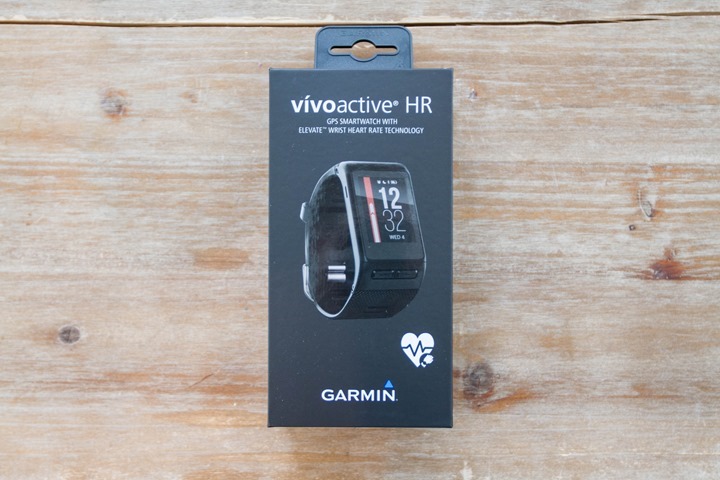
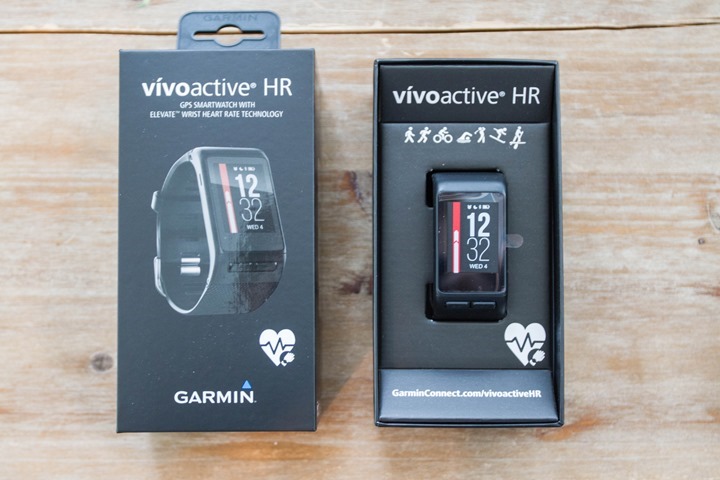
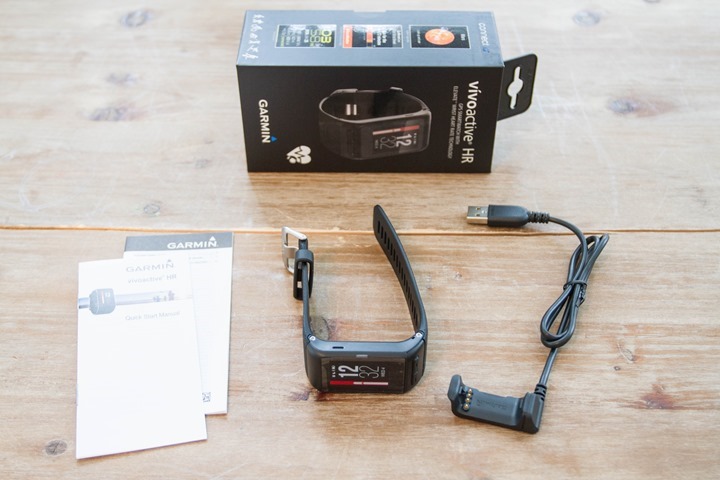
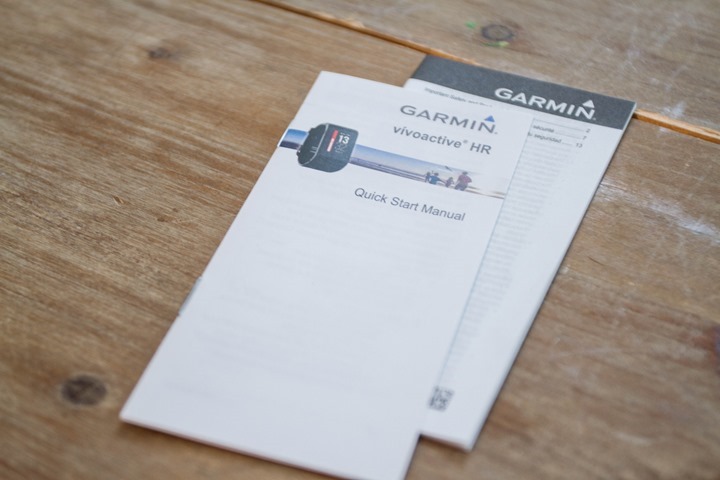
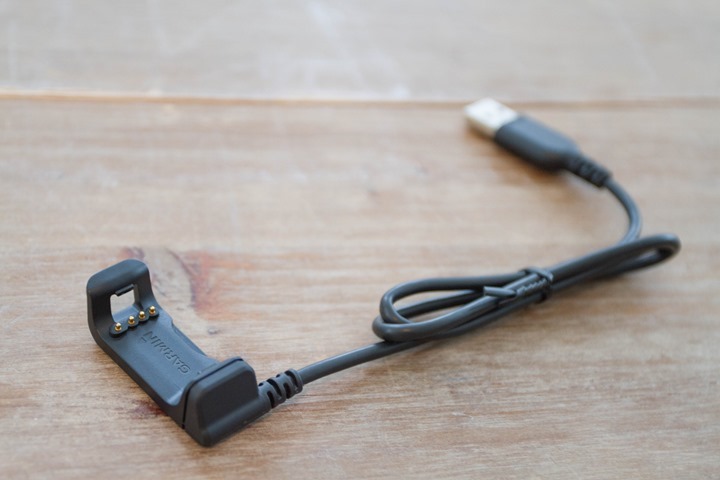
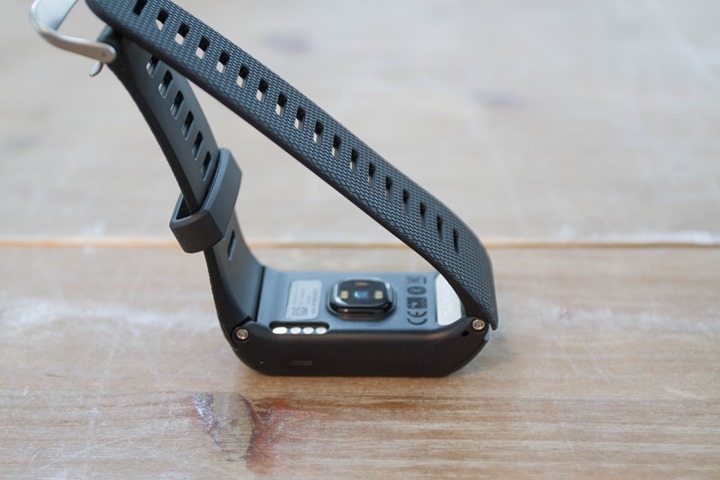
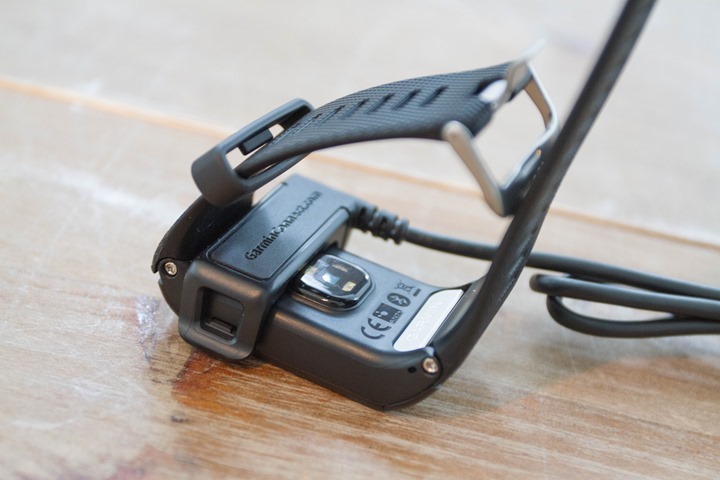
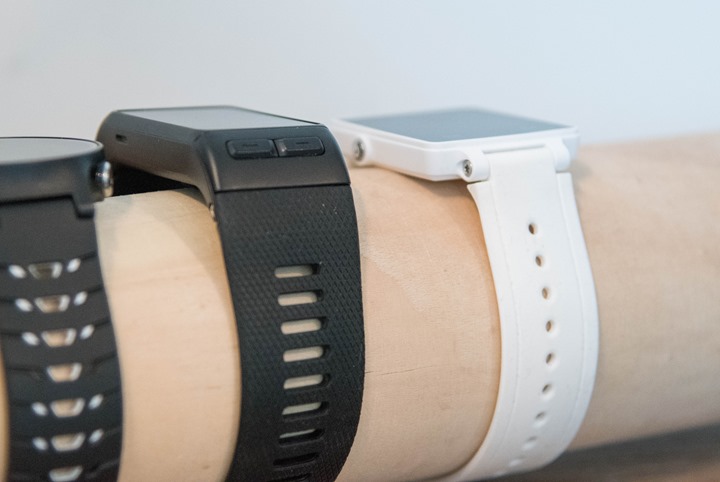
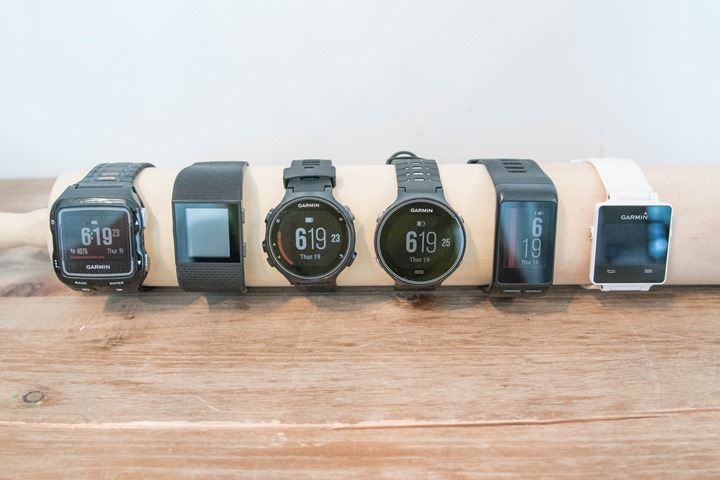
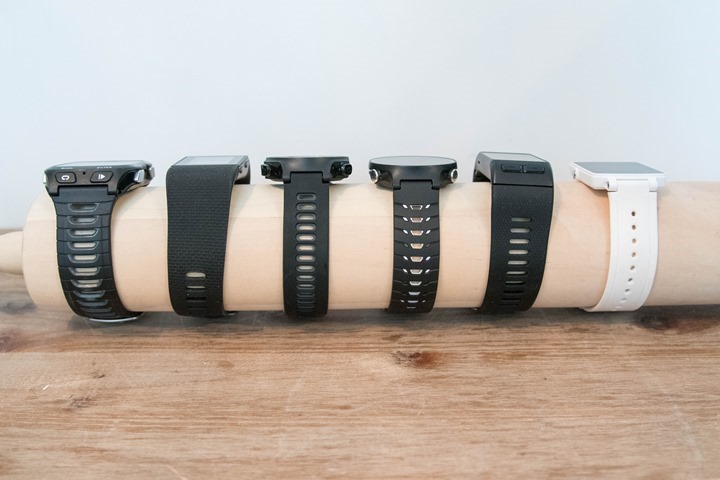

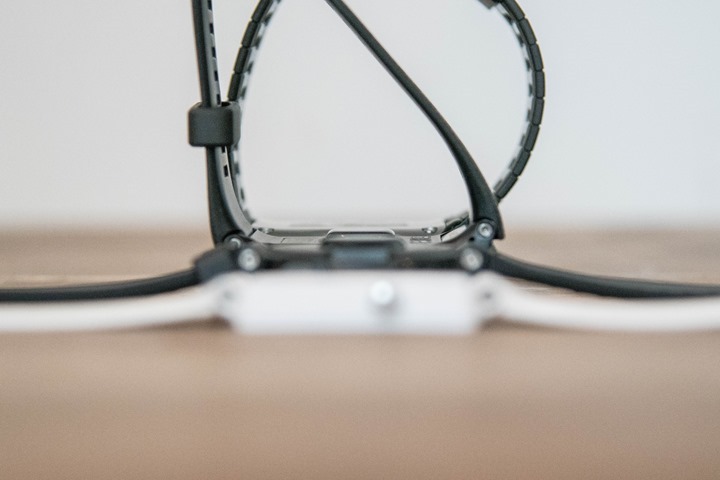
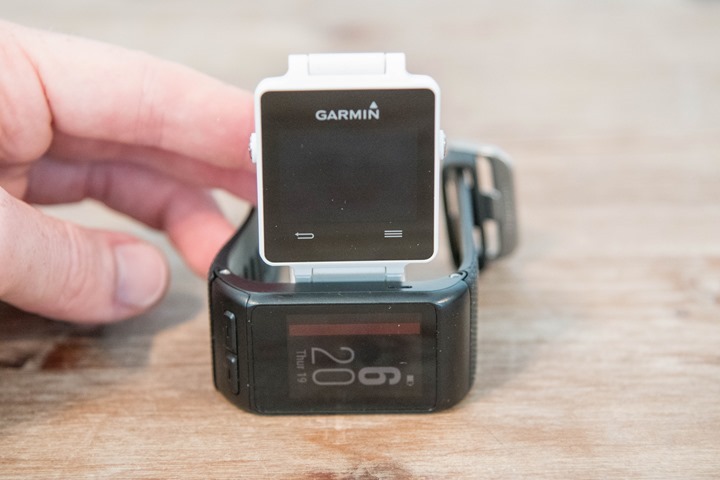




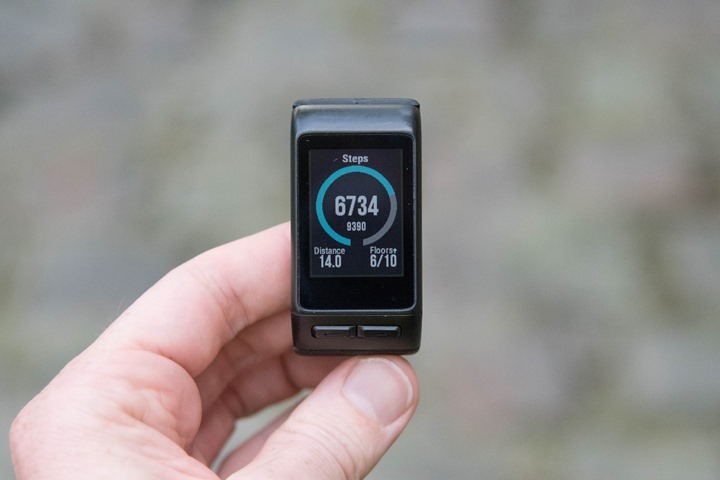
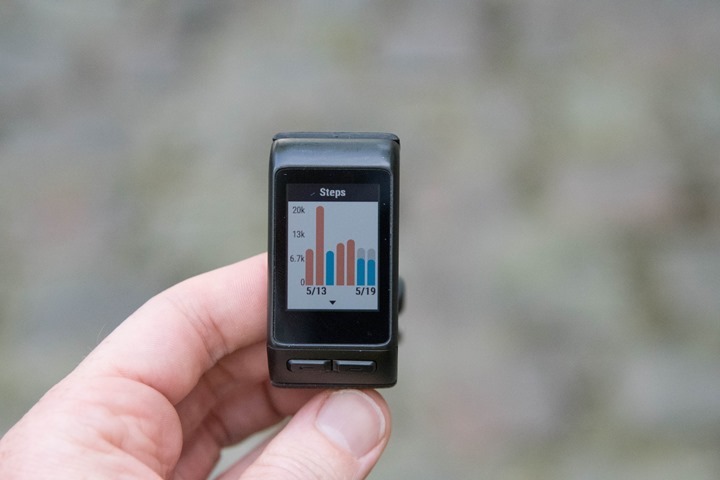
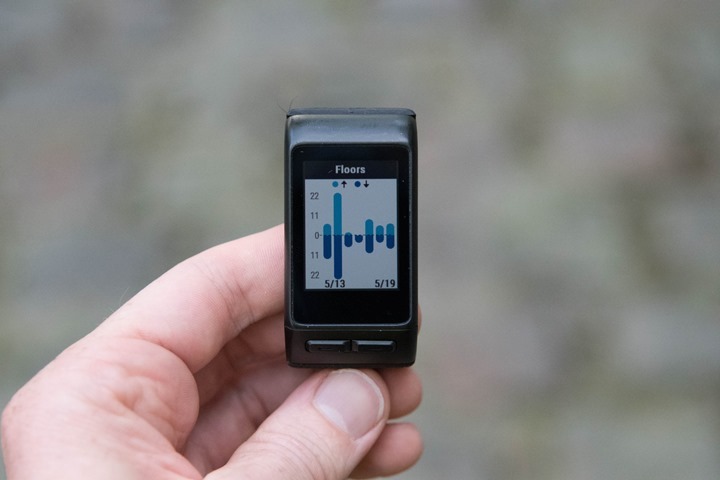
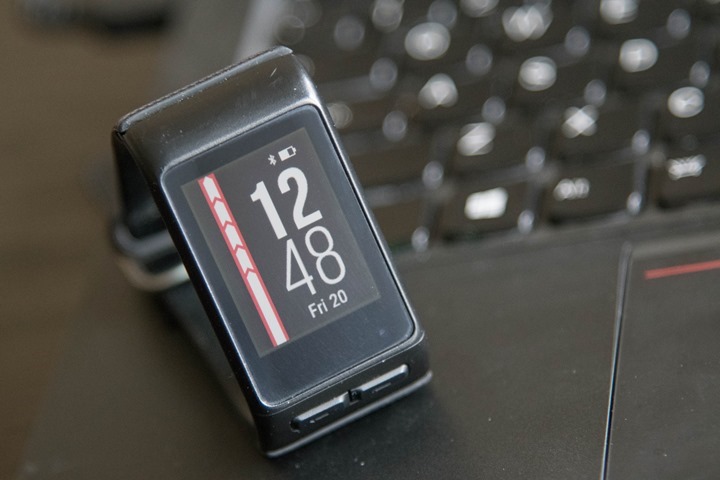
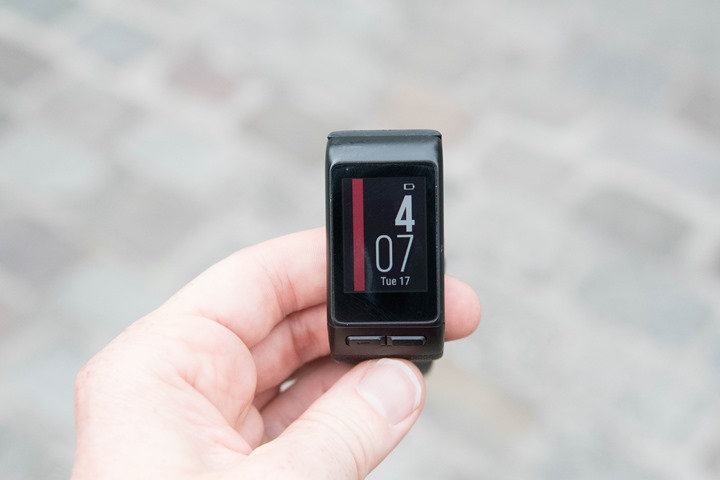
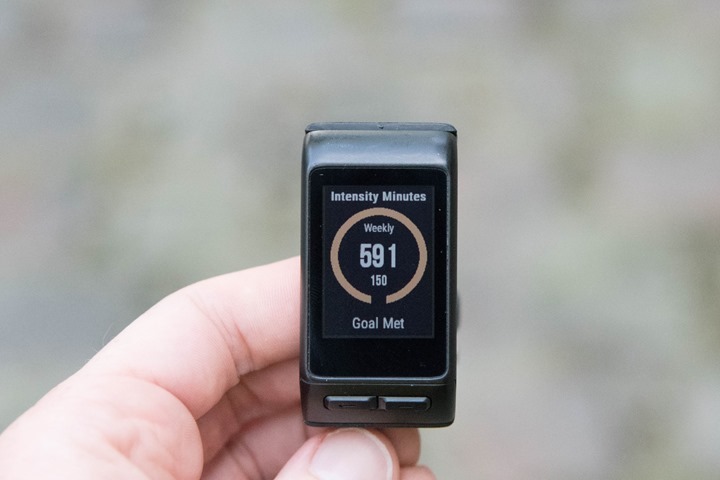
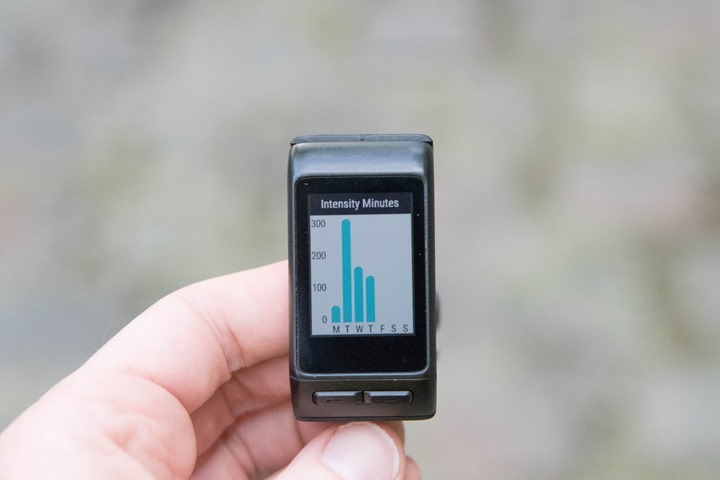
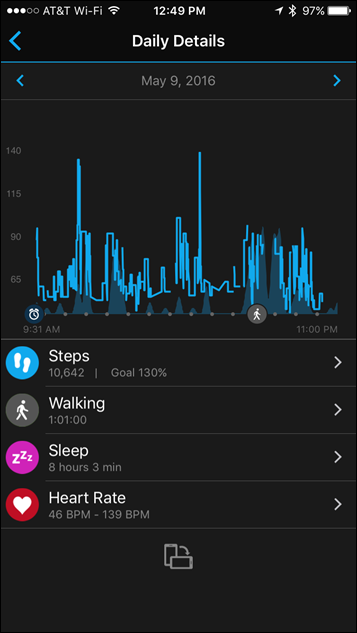
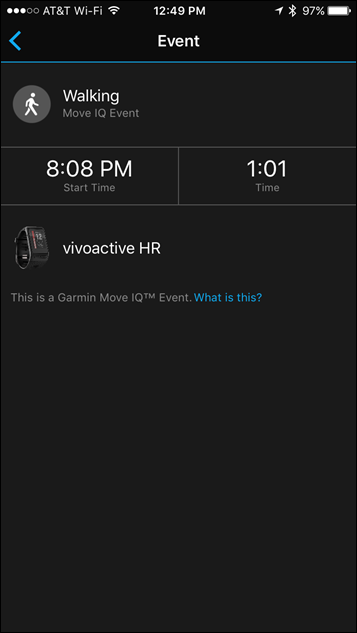
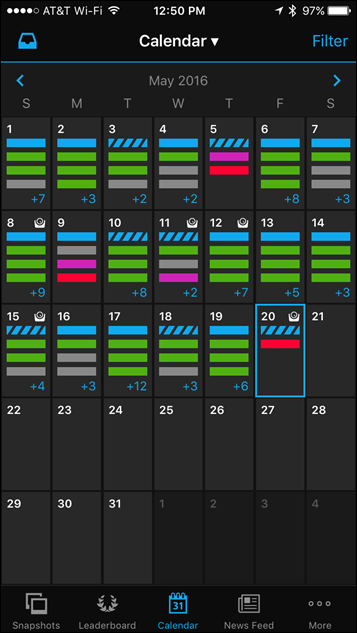
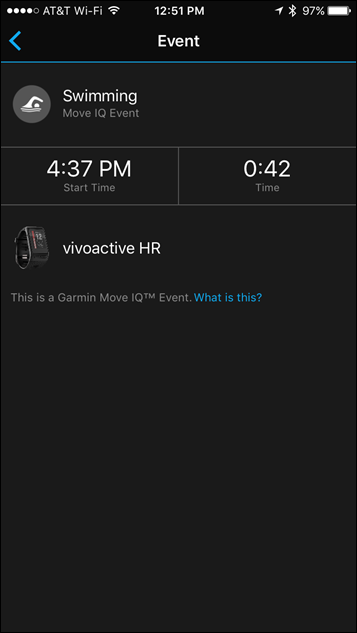

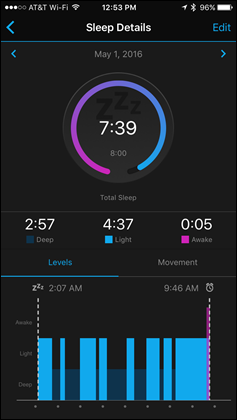
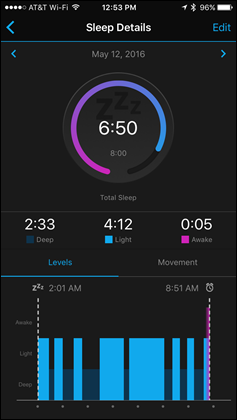




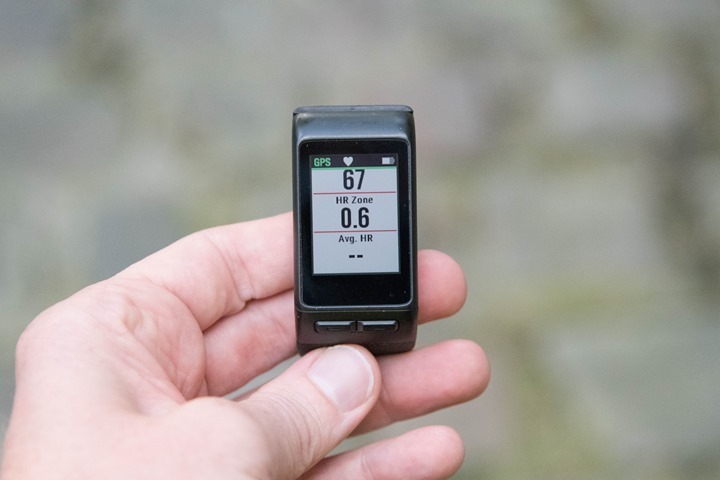
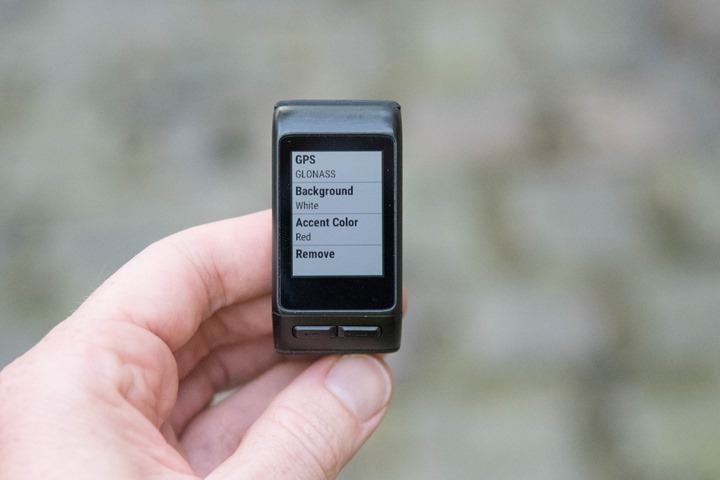
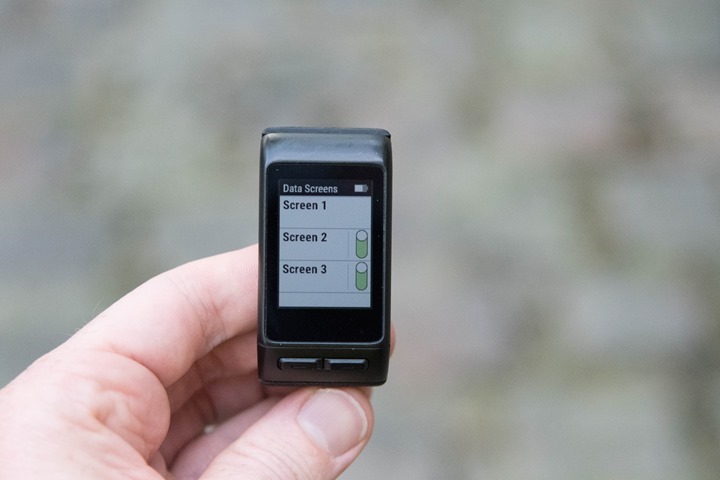
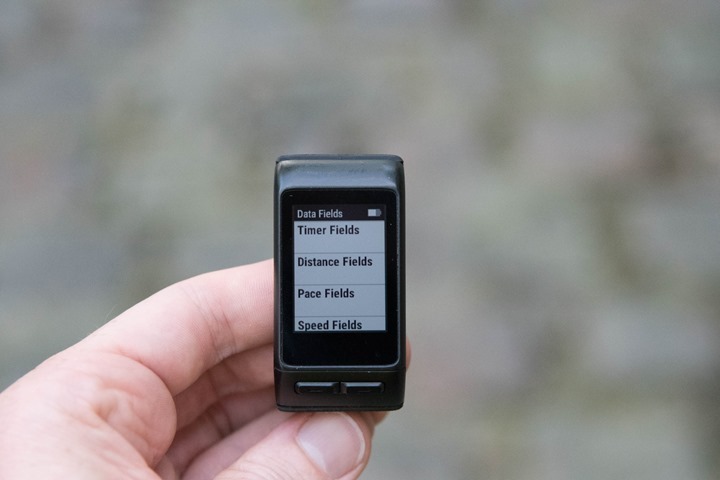
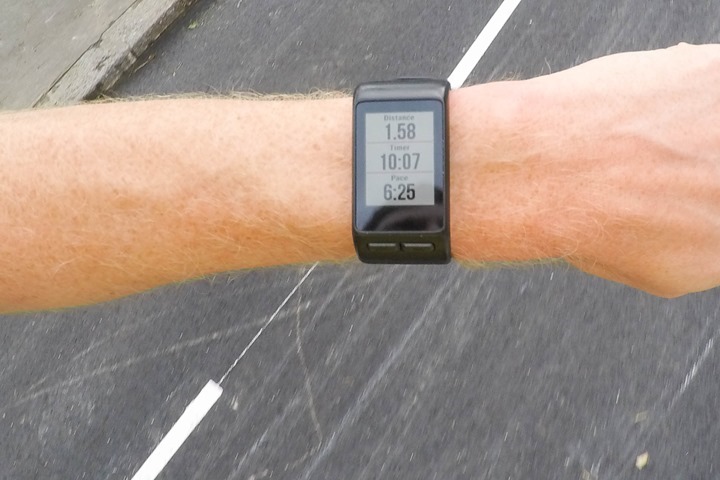
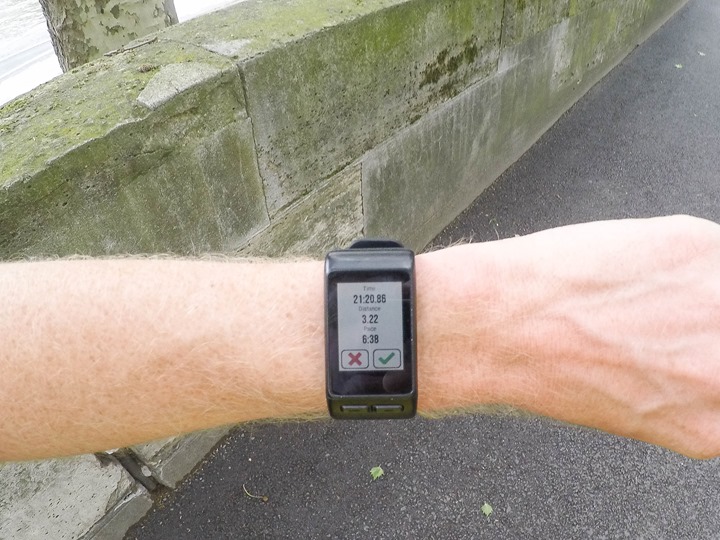
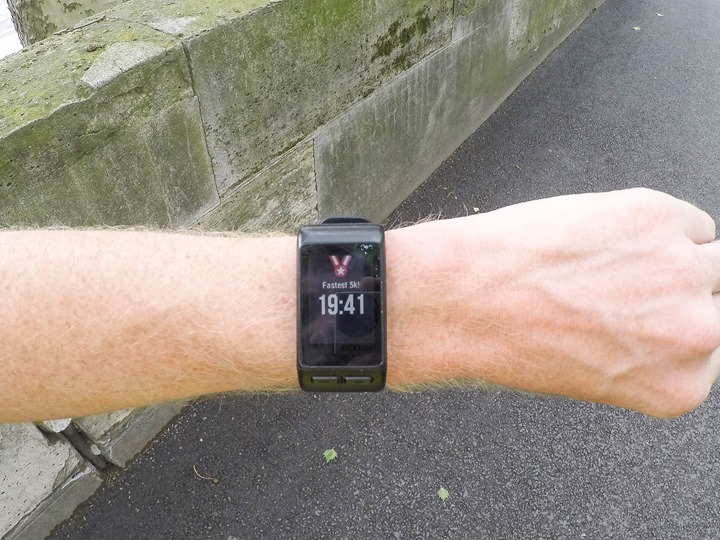
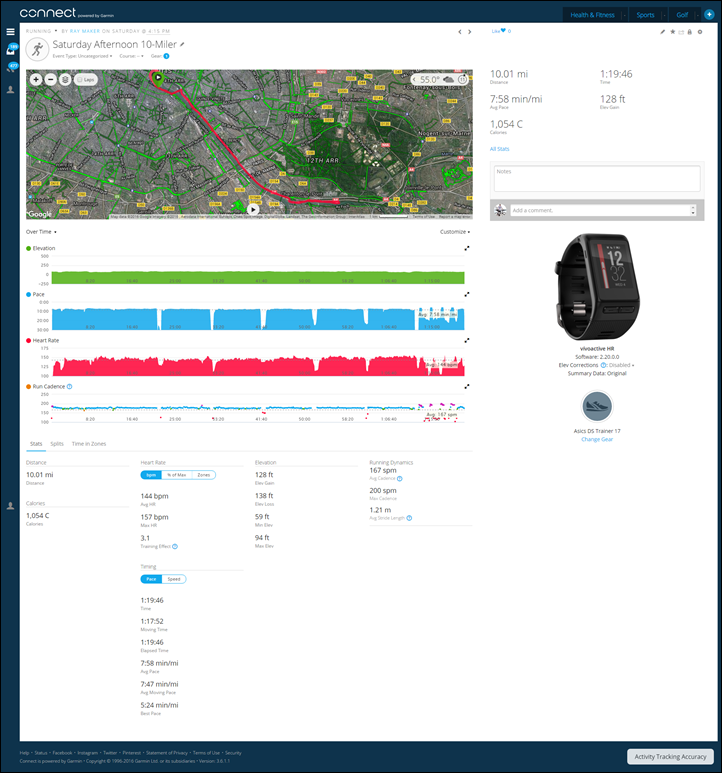
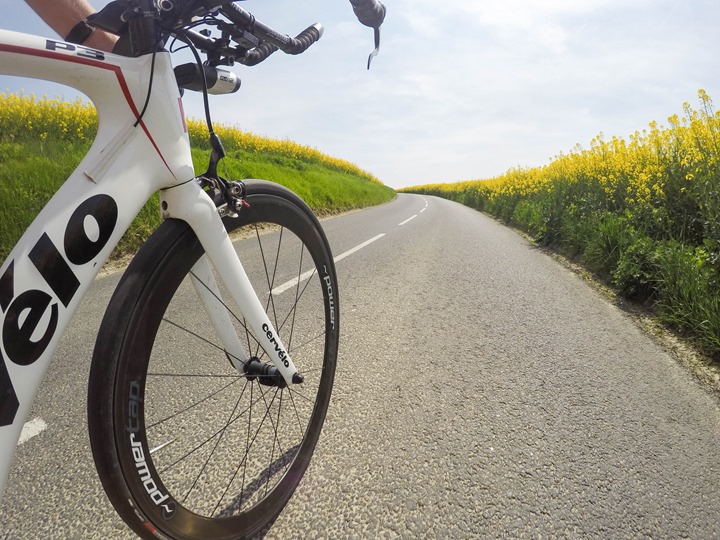

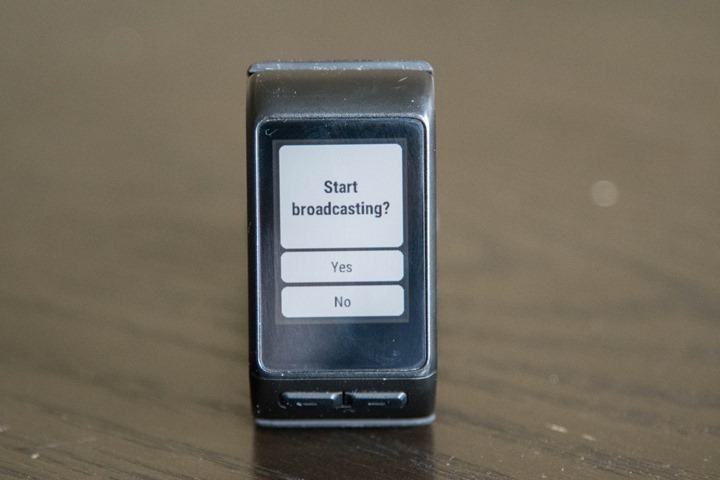
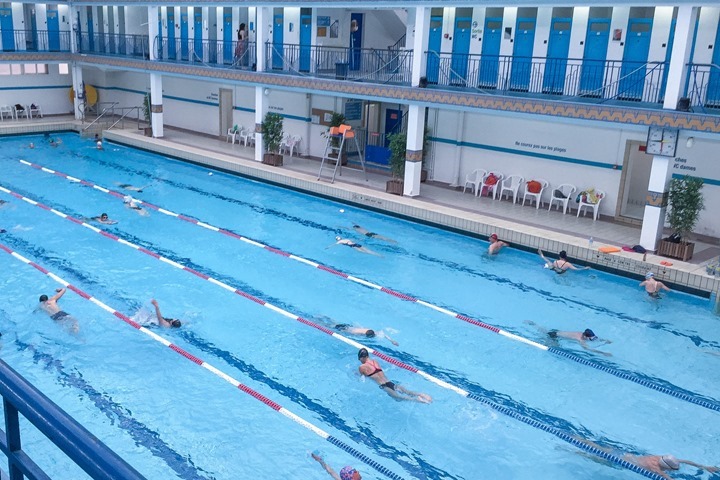
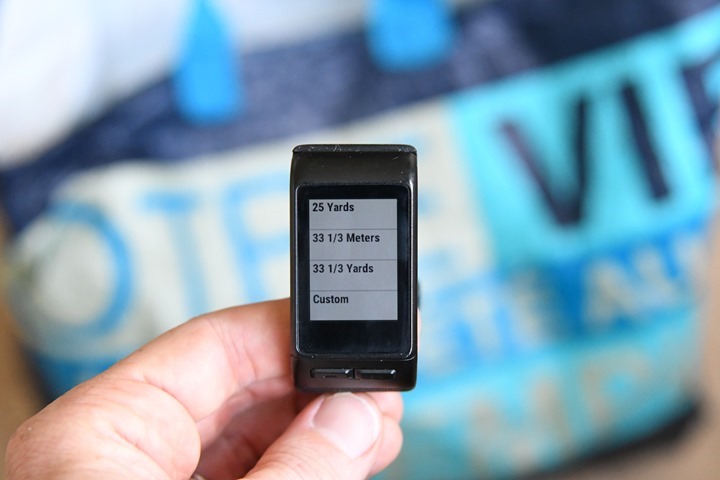
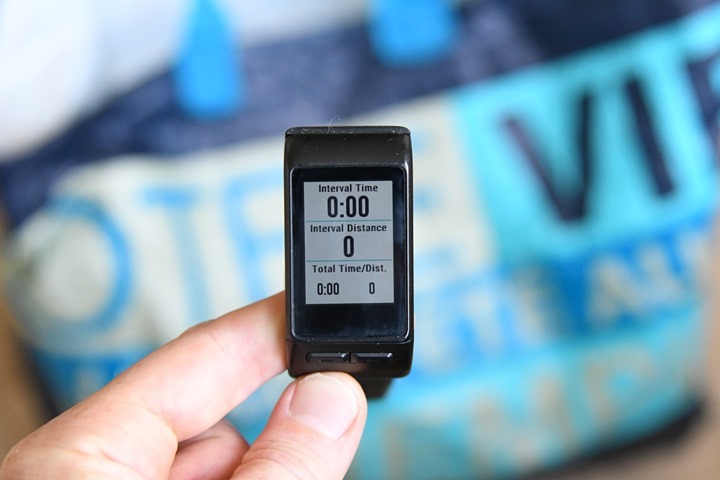
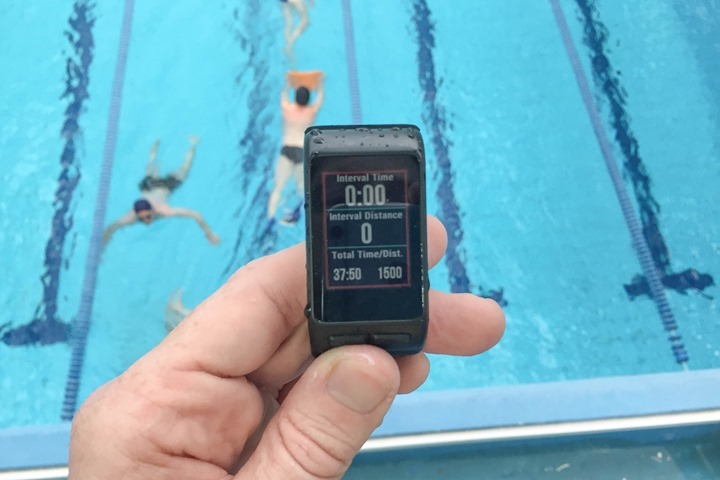

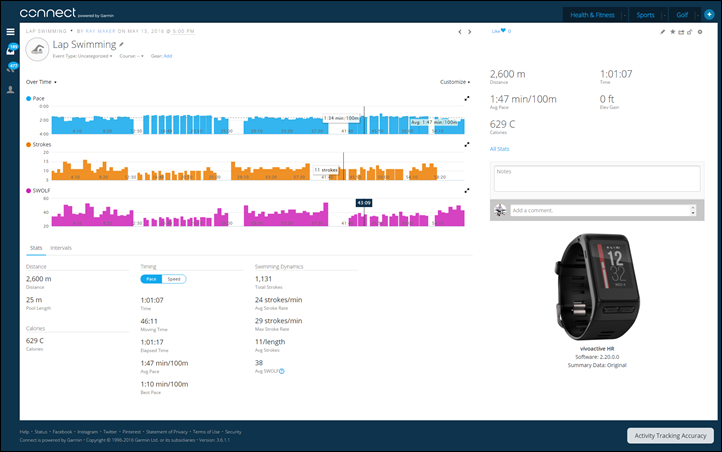





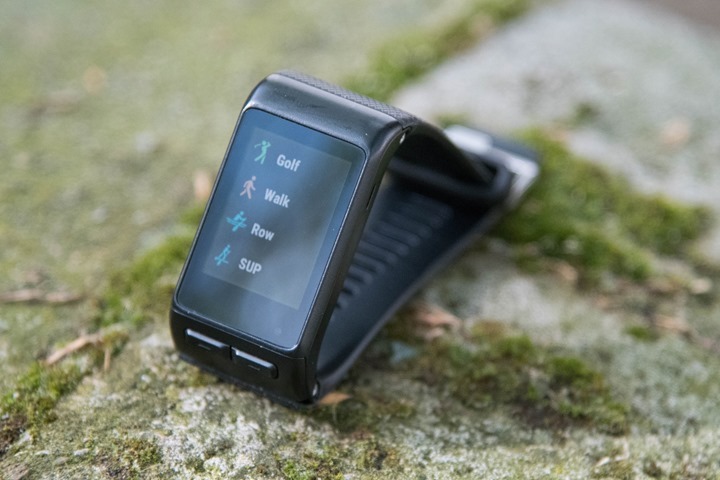

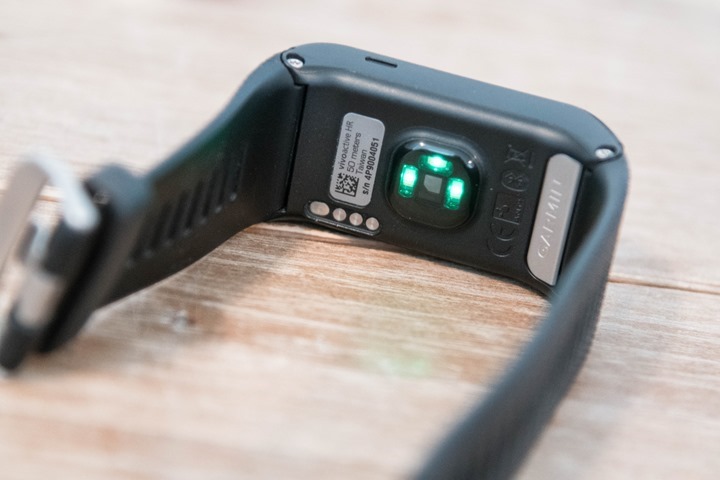










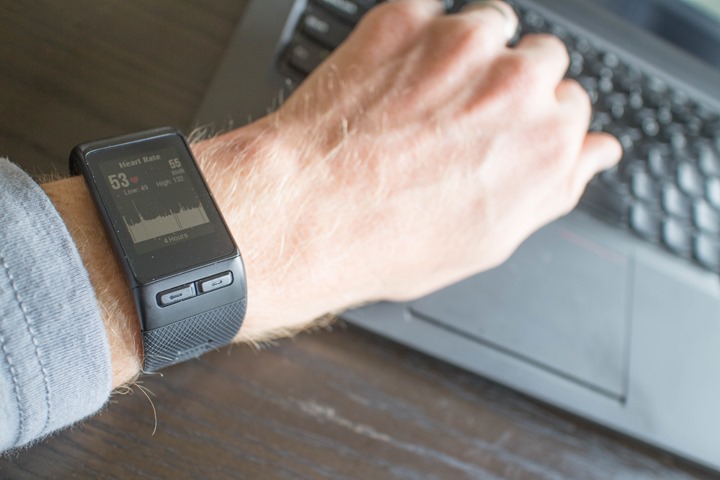
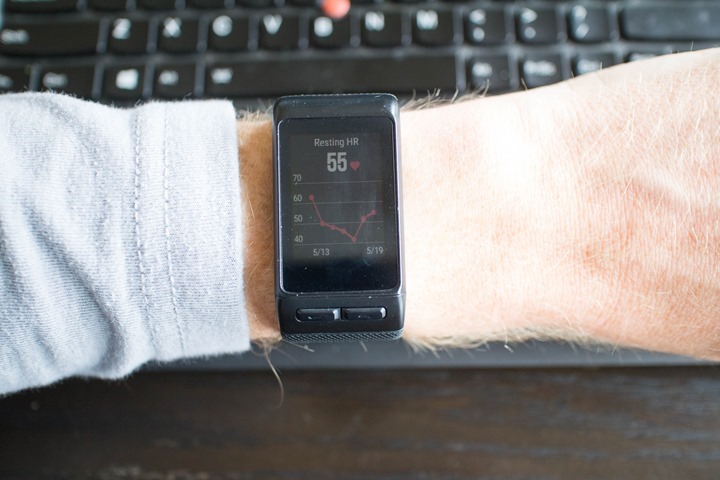
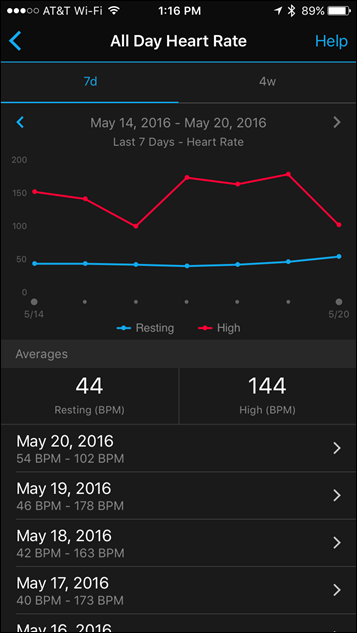
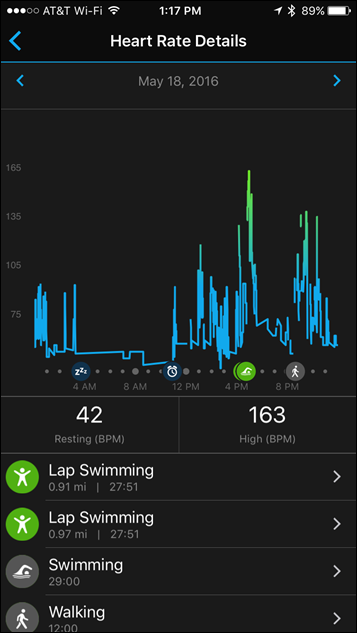












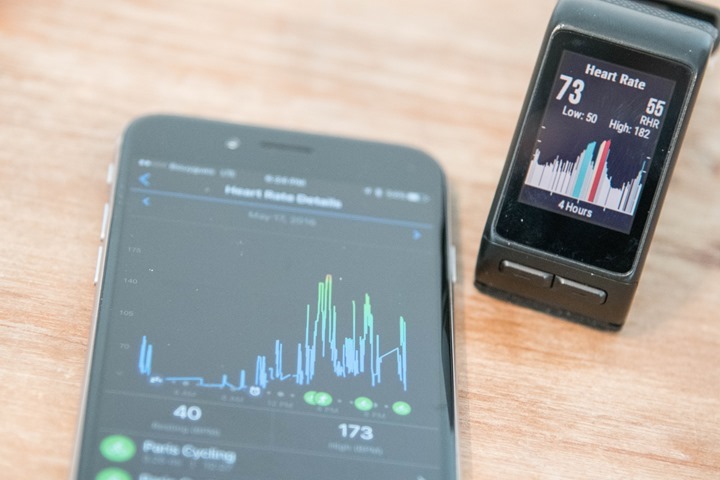
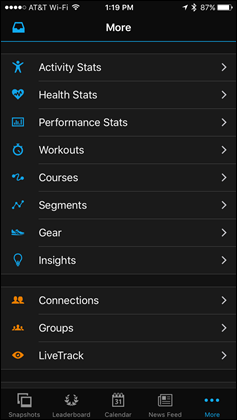
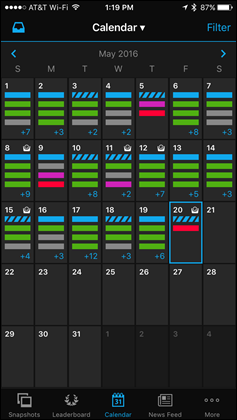

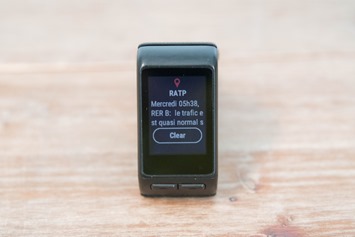
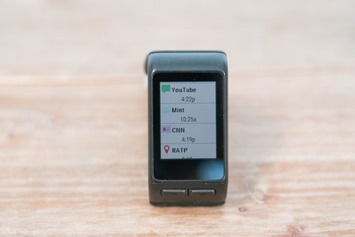
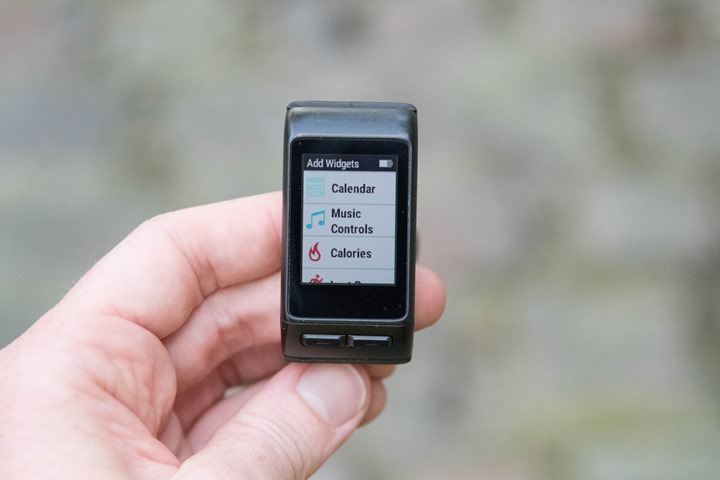
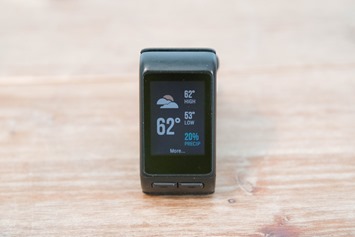
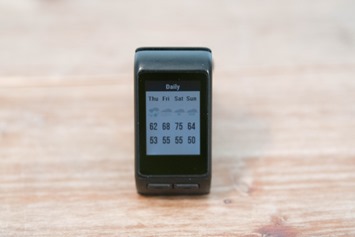

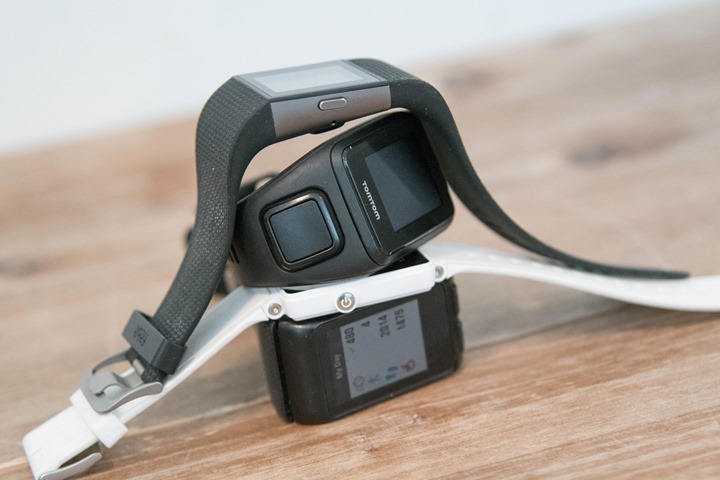
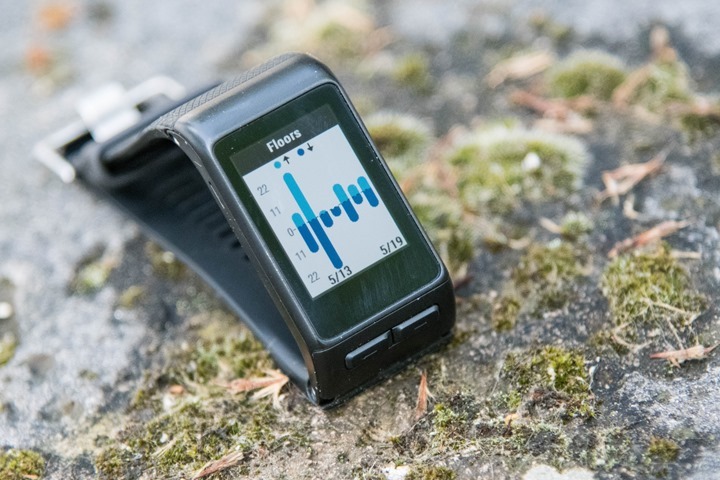


















Would you know how accurate calorie counts are during lap swimming? I figured since the optical sensor turns off I may be getting a much lower reading than I should be. I feel like I want to eat my weight in carbs but my Garmin states I’ve only burned 89c on a 400m swim (I’m a newbie and on the heavier side). Online swimming calculators give me an estimate of 249c.
Hi, maybe other people already talked about this but, I want to share my experience, and inquiry about vivoactive HR’s optical sensor precision. I have been using the VAHR for about three months now, I bought it “refurbished” on eBay, it works as it should or so I thought. I have a Vivofit, wich I love because of its simplicity and desing, and for my workouts I use the amazing Forerunner 310XT, wich I also love for its reliability. Well, my HR soft strap started failing, again, is the second one I buy, first one died on me a ear after I bought it, so I decided to use the VAHR as my HR monitoring source, broadcasting the signal, is here where I started to sense something was off, I knew I was at 170bpm or so and the VAHR was on 129bpm, the it would go up, and down again, all over the place, no t reliable at all, and very frustrating since I wasn’t able to manage my training as I use to. To further test this I decided to use both trackers, my VAHR and my 310XT using a new hrm1g which I know is working properly, well, I believe the VAHR optical sensor has to be faulty because the readings throughout the activity are so different, I believe the 310XT is the right one, for sure, I attached the picture where you can see that the VAHR (TOP) after a while the readings barely pass the white line. Is it this unreliable? Or is my VAHR optical sensor faulty? am I wearing it the wrong way? I would appreciate any inputs. Cheers.
My son has the Vivoactive HR, I have the Garmin Fenix 3 HR and my wife has a 235. Was recommending the Vivoactive HR as a less bulky and better value alternative to the Fenix 3 HR for rowing to many people until the screen cracked. Then discover other people have a similar problem… link to facebook.com. Since it’s a touchscreen and waterproof, any cracks mean you can’t use half the functions and of course it is no longer waterproof. I’m in the process of getting Garmin to repair it, but despite assurances that they respond quickly, it’s taken a few weeks of email communication to get to the point of needing to call them to pay up front. It would be great if someone could look into this and see if this is actually fit for the purpose of being a multi-sports watch…. I will definitely get a screen protector once it’s repaired, but buyers beware – it costs £100 to repair…
.
I’ve owned a Vivoactive HR for about 6 months now, and until the last update it was pretty useless for counting my swimming laps and distance etc, as it always threw in a few extra for no good reason. I’m a very experienced and smooth freestyle only swimmer, so probably one of the easiest people to track laps for, but it still couldn’t do a good job.
However, the latest update about a week or so ago did have an improvement for swimming included (not exactly sure what it involved), but it has since tracked my last 2 swims (60 laps of 50m pool) with perfection.
Am I too optimistic, or has Garmin actually made a huge improvement to the swim tracking?
Has anyone else noticed a drammatic improvement in swim tracking ability?
Thanks to this thorough review I picked up the Vivoactive HR two days ago (at a very nice price!). I was leaning towards the FR 235 but chose this for the altimeter. I’ve use a 310XT for years put started seeing how off the elevation was from friends after a hard hill ride or a hilly trail run. On yesterday’s trail ride the elevation was very close to the Edge 1000 my buddy was using. I just had my Garmin speed sensor yesterday and it would not hook up. As soon as my friend came by the VA picked his speed and cadence sensor up. Today I had both on the bike and it picked them both up. I wonder if you have to have both. I never usually put the cadence on the mountain bike as I ride single speed and the cadence is going to be whatever it will be. For the ride without the speed sensor the VA came in at 24 km and the 310XT, with the sensor, came in at 25.1 km. After today’s trail ride the VA, with both sensors, came in at 35 km and the 310XT came in at 33 km. Both were on 1 second recording. I did not set wheel size for the speed sensor on both. I believe they are both on auto calibrate. I’m now wondering if they always auto-calibrate or remember the last good ride. I switch these sensors back and forth between my road and mountain bikes. I’m wondering if I should set the proper wheel size each time. It could also be that with GOSNOSS the VA is just more accurate (I’m hoping).
I must admit I do like the round, classic watch look of the FR 235 and its display, but the altimeter and the fact that you can get 4 field and 6 field displays in the Connect-IQ Store sold me, along with the price. I was really trying to find one watch that would do everything I wanted, but I didn’t want to pay the price of the 935. I was really wanting to be able to load found courses for trail sites I hadn’t ridden before, which the expensive TRI watches will do, and to my surprise I’ve found apps that will do this for the VA. So it seems the VA has a lot of bang for the buck.
Last thing… The HR readings seemed pretty consistent and decent for the two rides. I had it on pretty tight and with all the jolts of mtb riding it started to dig in and started to become a bit annoying. I’ll have to see if one notch looser will still record well. I’ve a pretty skinny wrist though so more meat would likely help.
So… pretty happy so far. I agree that it is hard to read indoors, but I am going to be using it more as a sports watch and not an activity tracker. With my running and biking I don’t have to worry about stairs, steps and keeping moving (even at 58). Maybe it would be nice if it have Bike 1 and Bike 2 so that I could set the wheels size for each once and for all, but I can likely live with it.
Thanks again for the great review and all the reader feedback, questions and suggestions!
Rob
Screen is fragile. Even with protective cover mine cracked with no hard impact.
Garmin wants almost as much to repair as to buy one online.
Due to this I can’t recommend.
As a mountain biker that crashes a lot, it does annoy me that they don’t recess the screen a few millimeters for protection.
I ordered one of these. My plan is to put it on the watch whenever I go mountain biking or trail running as I’ve taken a good tumble doing both. Too bad it takes so long to ship. I could not find one in North America.
link to ebay.com
Rob
Aren’t you likely to break your wrist if you slam there anyway? :)
I have to disagree, I’ve had mine about a year now and knocked it a few times. Apart from some shine marks to the case, its in excellent condition. No screen scratches whatsoever.
great reviews ! great blog. Makes me miss Paris : I used to train around the Champs de Mars … easy on the joints as its an earth track .
Am in the process if trying to buy a second hand gps runner … am probably looking at a Garmin 210.
I love the watch and have been using it for over a year. When will Garmin update this watch? Looking for thinner and better/bigger screen. When already?
Thanks for a great review. I have a 735xt with TRI-bundle and am considering buing a VAHR for my son, and wonder if I interpret the following sentence correctly: “Note that the Vivoactive HR does NOT connect to either the HRM-SWIM or HRM-TRI from a swimming data standpoint. It can use those straps for straight heart rate data while above water, but it cannot download HR data from those straps while in the water.”
Could the HRM-TRI collect the HR-data while swimming and transfer it to the watch after the swim, above water, so that the limitation is that you don’t see your HR-data DURING your swim, but you could look at the HR-curve AFTER your swim, eg using Garmin Connect?
thanks for the review, haven’t seen in detail review like that. great job!
i am thinking of purchasing this watch (mainly running, swimming , gym workout) i was wondering, do i have to be connected my smartphone all day?
i want to connect one time a day and that the watch will synchronize all the data,
i am not willing to go for a run with the smartphone, any problem with that?
i guess that for music i cannot count on the watch and will have to find other solution if i am going to leave the phone at home..
thanks for the replies in advance
Hi Ray!
Your review was very useful! I’m trying to figure out which is best for me… the VivoActive HR or the VivoSmart HR+. I do not run, swim or golf, nor row or SUP but I do hike, walk, sail and get on my spinning bike 3 times a week. I’m a stats geek, and need HR information and GPS recording on my hiking (including hights of course). The only reason I’m not definitely choosing the VivoActive HR is the size, since if the idea is to wear it 24*7, I have some doubts on the bulkiness or lack of feminine style (not extremely important, but might be an issue). Therefore… I would really like to know if I would be really missing some important or detailed stats with the VivoSmart HR+. I’m not particularly keen on having all the stats on my wrist, so if I could have all the information needed on my phone/tablet or other device, that would be fine to. I love coming back from hikes and having all the information on what I did and my general performance. My idea is to track as much information as possible, in order to improve my general fitness.I can’t figure out if the VivoSmart HR+ would be enough or I should lean on to the VivoActive HR.
Could you please help me out?
Thanks!!!!
I just recently purchased the Vivoactive HR and I am very impressed. I’m not one who likes to stare at numbers during a ride, but I like data to refer to afterward and I like to keep track of my rides. The BPM on the watch is surprisingly accurate, the screen in much clearer and brighter than I would have assumed from reading reviews (especially using the Split app by Stanislav Burres as the main screen), and everything about it just works. I don’t have big meaty wrists, but I don’t feel the watch overpowers my arm and looks stupid. It looks more like an athletic tool than a wrist watch, but that’s ok. It’s just a great piece of gear.
Dear Ray ,
Thank you for this very nice review , the best I have found .
I am French speaking myself ( Belgian ) are you French or living in Paris ?
Anyhow congrats for this great work and very precise information
Marc
Hi Ray, I’ve analized the electromagnetic field of my vivoactive. This is the value when bluetooth is on: 1,436 v/m. In the next post I’ll show you the value with bluetooth off.
Now we have 167,3 mV/m = 0,1673 V/m with bluetooth switch off. Whit bluetooth on we have about 850% more electromagnetic field close to our skin 24/7. Are we sure that this is whelty? Thank you. Sorry for my English.
I love this review and all the DC reviews are the best.
I´ve owned a VAHR for 9 months and it died. Screen started to go all distorted and battery lasted for less than a 4 hours. Also a friend of mine with the same watch got a really similar problem with the distorted screen after less than 6 months of usage. Anybody else had this same experience?
This really sucks because I love this watch. There’s nothing better at this price range. Hope I can workout the warranty issues as I’m living in South America where support is nonexistent.
I didn’t notice how much I’m used to the watch after I’m missing it now.
Vinicio,
I just had the same exact thing happen to my watch last weekend. Battery ran down within hours of charging and screen got all messed up. After that it would not take a charge.
Fortunately I had bought it at L.L.Bean and they have replaced it already. No questions asked.
I agree, I love the watch and hope this was a fluke and doesn’t happen again.
I had the same issue i replaced my VA HR 2 times because it suddenly blacked out and never started again. I was told by Garmin to do hard reset and put on charging again. the watch came back for few minutes and again blackout . I really liked the watch but I was unable to understand how it suddenly flashes then blackout and stops working. I thought maybe i am the one having issues with this later when i posted the question on Garmin forum i came to know many people are facing the same issue and then I returned my watch. I am still in search of something similar but my experience with Garmin vivoactive was really bad.
I was wondering about the graphs when you sync the watch data from an exercise to the Garmin Connect app. When ever you look at the data graph for Heart rate, elevation, Pace or cadence, it always places “Time” across the bottom of the graph. Is there any way to change the graph so the Distance appears across the bottom of the graph. I think it would be much more meaningful.
You can change to distance through web interface on computer, but not on mobile device.
Thanks Steve.
Can this play music so you don’t have to carrie your phone while running?
I’ve had mine since February…its been a great all around performer. Yesterday morning I noticed the screen was cracked. Odd as it was not cracked the evening before. So, sometime between going to bed and leaving for work the next morning it cracked. Thought back on my morning and could not think of what I might have done to crack this…no bumps or hits on anything that I can recall.
Did a google search on repairing this and found a FB page/post of LOTS of people that are getting cracked screens on this, many of which mention the same “how did i do this” scenario.
I see now garmin has discounted (20%) this device on their site….hmmm.
This is the second garmin I’ve had with a screen break (first was a 230) with less than a 1 year usage. Maybe they need to find a better material (base on my experience and the many who are reporting the same issue)?
Does anyone have info (specs, release date, price, etc.) on the next Vivoactive?
if you do a google search for Vivoactive 3, you will see its new design has been leaked though not much in the way of details. Whats interesting, is it finally looks nice rather than the plasticky version we have now, so I’ll be a buyer if the price is kept reasonable.
Does the garmin connect measure the calories correctly? IMO it shows some exaggerated numbers.
Got the VAHR on Friday and took it on a Trailrace yesterday – got 15Hrs and as I crossed the line was able to stop and it died :-) Carried a 310XT on the other arm and there was about 300m difference in distance. Not that bad over 80km with 2600m of climbing
Hello! This is a great comparison. I am having trouble though, I am looking for a fitness tracker, but I cant decided which would be the best for me. None of them seem right. Wondering if you could make a suggestions since you have used so many.
1. price is not important – just want something that works
2. I bike, canoe,swim in OPEN water, walk, and do cardio/dance workouts and I want to track all this
3. I am not super crazy into metrics. I just want to know how far, how many calories, and a few other basic things
4. Battery life is important, must be water proof.
Any suggestions? I have spent so many hours researching and I am not any closer to deciding
2. For me the V-HR has been great for cycling. My understanding is that it records paddling data very well–cadence, distance and heart rate–but for swimming you don’t get distance because there is no gps tracking for it. Calories for all exercises is good, because that’s figured off pulse. The V-HR is waterproof and the battery life, in my experience, is excellent. I get nearly 20 hours on gps, 6 or 7 days w/o gps but with bluetooth on, and, amazingly, about three weeks with no gps and bluetooth turned off. For cycle touring the last of those is important, because there’s no way I want to (or even can) recharge every night, but I’d like to keep some record of the trip. With gps off the V-HR automatically records my tour as cycling, recording duration of time and pulse. At the end of the trip I turn bluetooth on and sync to my phone.
I guess for swimming in a lake or such, you could at least get HR and then calories burned even if it did not track distance? You would still know you did something for an hour etc. correct?
The info on cycling was helpful thank you!
After a couple of months of frustration I have given up on my Polar M430 (simply could not get the Polar Flow app sync to work consistently) and Polar has agreed to accept a return. I would really like to get a replacement soon and have narrowed the list down to the Vivoactive HR and FR235 and I was wondering if you would still recommend the Vivoactive as the better option based on your comments in the 2016 holiday buying guide.
I am a pretty casual runner…typically 10-12 miles per week and I run a few 5Ks every year. I do, however, bike quite a bit, want something that will track my daily activity, and would like to have continual HR. The FR235 also seems a bit bulky to wear 24/7.
Since the Vivoactive has been out in its current state for a bit is there a replacement around the corner that I should wait for?
Hi! Your review is very detailed and useful! I’m in the middle of the decision of my purchase and I am not sure what to do. I walk, just started boulder practice, general training sessions, love to go trekking and sail (I can spend some time on the water if my laser capsizes). I do not run, ski, golf or SUP. I am very keen on stats, and need a 24/7 HR monitor. I need to improve my cardiac resistance, so that is important for me. I spend a couple of days a week on my indoor spinning bike as well. GPS location and altimeter are important to me as well since I like trekking tracks and information. So the VAHR seems the perfect fit for me.. my only doubt is if it’s not too bulky to use 24/7 on a feminine wrist. I’m not very petite, since I am 5,7″, but anyway…. could you please give me your thoughts? Is there any other wearable with these features but less bulky? any new release on the VAHR? That would be great!! I can’t try it on where I live, so I can’t really see it on my wrist. Thanks!!
I did my research on what fitness watch to buy then came across this review site. It was very detailed, informative and impartial. As well as confirming what I already found out it provided more indepth information (better than the Garmin site) that made me feel comfortable to go ahead with my purchase.
Thank you
In Strength Training mode can logs and Automatic rep counting ?
No, unfortunately only for Garmin’s 2017 devices.
Thanks for your helpful and thorough info! I have been reading up on the Vivoactive HR vs the Suunto Ambit 2 S…I am looking for a HR & GPS watch with the best battery life possible that works for multiple sports (mtn bike, trail & road running, rd biking, hiking). I am a competitive adventure racer, ultra runner & mtn biker. I am also looking at price point (of course). These two have some deals right now which is why I am looking into them… Which would you recommend between these two options?
Thanks for the help!
-Em
Has anyone come across a connect app for the vioactive hr so the watch can be set to vibrate every 27 secs or so, so it can be used as a tempo for swimming etc bit like the fins tempo that bleeps every so many seconds so you can keep pace with out looking at your watch. Would love this feature
How does the floor counter handle escalators?
As usual, thanks for the excellent and thorough review. I’ve had a Garmin Forerunner 15 (which I bought after my son co-opted my 10) and have been thinking it’d be nice to have something with a built in HR. I’m not a super serious runner but I do run, swim and row (indoor and outdoor) so this watch seemed like a *perfect* fit. Reading some updates here (and elsewhere), it seems like the screen is a dud and that more than a few watches just stop working about 15 months out. I’m so bummed, really wanted to buy this but can’t risk dropping a bunch of money on something that may very well break within a year or so.
Have you had these issues and if so, any thoughts on another, comparably priced watch that also has hr and rowing capabilities?
Do you know if there is a way to pair the Vivoactive HR with an Edge 520 so that the 520 displays HR from the Vivoacitve (rather than using a chest strap)?
Hi Jerry, Garmin calls this “Broadcasting”:
Broadcasting Heart Rate to Garmin® Devices
You can broadcast your heart rate data from your vívoactive® HR device and view it on paired Garmin devices. For example, you can broadcast your heart rate data to an Edge® device while cycling, or to a VIRB® action camera during an activity.
NOTE: Broadcasting heart rate data decreases battery life.
Hold .
Select Settings > Sensors > Heart Rate.
Select an option:
Select Broadcast In Activity to broadcast heart rate data during timed activities (Starting an Activity).
Select Broadcast to start broadcasting heart rate data now.
Pair your vívoactive HR device with your Garmin ANT+® compatible device.
NOTE: The pairing instructions differ for each Garmin compatible device. See your owner’s manual.
I’ve had mine for 18months, and it’s been pretty good, but it died on Sunday, during a family swim at the local pool. It started buzzing non stop on my wrist, and the screen had gone, despite ongoing buzzing.. The buzzing stopped and that was the last life it has shown. It won’t take a charge and it won’t turn on. If you squeeze it slightly with your finger on the screen and thumb on the back, water seeps out from between the screen and the body. It had clearly filled up with water!
In summary, don’t expect the waterproofing to be all that. I’ve since googled this, and there are plenty of others out there with similar experiences. In the Netherlands, where I live, there’s a two year warranty, so I’m now going to try and sort out the replacement, but elsewhere, I gather it’s only a year (the USA for example) and I’ve heard they quote a charge of about $120 to repair this problem…
Something to chew on…
Mine just went the same way. Swimming in a pool in Mexico.
Don’t trust the waterproofing!
Mine was nearly two years old and I had otherwise kept it in great condition using screen protectors etc.
I just bought the Vivoactive 3.
Had it a couple of weeks.
So far so good!
My Vivoactive HR died from swimming in a pool as well. Got it replaced under warranty and over the weekend I killed the replacement sitting in a hot tub (it is out of warranty). The waterproofing on these is garbage.
I just bought a Fenix 5x and I’ll not be taking it in any water other than the shower. I don’t trust Garmin’s waterproofing anymore.
My vahr seems to be dead due to a sea swim the other day. It worked afterwards but the battery drained 100-0 in 9 hours instead of 6 days. Next charge, drained in half that time. Now its just a black screen and charging seems to have no effect – screen doesn’t show charging happening. I’ve cleaned the charging contacts and I’m trying one more time to charge.
I think it’s nearly 2 years old. Terrible shame as kept it well protected with screen protectors etc and hoped to get many years of service for the cost.
Same for me, died on the pool. I wonder if there is a suitable alternative? this review is a bit old
The most current product in the Vivoactive lineup is the Vivoactive 3/3 Music: link to dcrainmaker.com
I’m probably not the only one who reads the most recent comments here whenever I have an issue with my vivoactive HR, so I thought I’d share what I just learned in the hope that it helps someone else. My watch just updated to the latest software, SW 4.30. This new release eliminates the feature to set the backlight gesture control to “during activity.” I loved that feature, but now the backlight gesture setting can only be Enabled or Off. Sad panda.
The Garmin forums are broken from what I can tell so I can’t post this there. I chatted with Garmin Support and they said that the feature wasn’t working correctly so they eliminated it in this software release. I told them to please count my vote to bring it back.
Hello!
Just recently bought a VA-HR, using an Amazon promo, and i wasn´t undesrstanding why i had so many cycling events from Move IQ, when i didn´t went for a ride…
Didn´t went for a ride on a bycicle, but went for a ride on a motorcycle… VA-HR thinks its cycling! :)
Had to turn off Move IQ.
Just picked up a vivoactive hr, I have an index since years. Some weird questions. 1. How come cycling data from my edge 1000 via Garmin connect doesn’t populate over to the vahr as last sport? Last support only shows activities recorded via the vahr!? Stupid. 2. Weight data groom the index should ideally also be shown on the vahr but it’s no where to be seen. Also stupid. Other than that it’s great. Cheers.
Once again, very thorough and helpful review! My husband’s Forerunner 220 recently died and he got this watch on sale, after reading your review. He’s very happy with it.
I’m also looking at this now for the smart watch capabilities, but my question is… are you aware of a watch that’s comparable but in a smaller size? I have really small wrists and can’t seem to find anything that doesn’t look foolish. A junior watch would be perfect, but there aren’t many and especially with these features.
Thanks in advance!
Maybe the Vivoactive 3?
@Ryan: Sorry, miss your reply. I’ll check out the Vivoactive 3. Thanks!
As a golfer as well as other sports I would like to know if the watch does golf gps stuff without the need for a phone.
Hi there,
I may have missed it. Is there a way to access my routes that I have built into my app?
Kudos for your review man. Thank you. I’m between the Vivoactive HR and the Fitbit Versa and I don’t know which device should I buy. Any thoughts to help me decide ?
Kind regards
Whenever I run in the rain, I think, “man, I’m glad I don’t have a touchscreen watch!” Also, when wearing running gloves. Isn’t the touchscreen interface problematic in those two conditions?
Three swiming watches tested so far.
Swimovate poolmate 2 – loads of mistakes, whatever the style.
Garmin Swim – Less mistakes, mainly when changing styles. Strava distance issues as well.
Garmin Vivoactive, some mistakes, bur very rare.
———————————————————————————————-
Garmin Vivoactive so far proves to be the best swimming watch around.
Don’t waste your money on other watches.
Thanks for the review.
This was the best description and function of the vivoactive hr watch that I have found. It was clear and easy to understand. I also love the comparison of the other watches. Keep up the good work! The best thing is you are able to stay healthy and help us to choose the best device for our personal needs.
Thank you
Tammy
Overall the Vivoactive HR is a pretty solid multi-tasking unit. It seems to track GPS on cycling and running accurately, and I haven’t had any issues while in the pool either. It’s not the most advanced watch Garmin makes, but it’s also not the most basic. It sits nicely in the middle of the road and offers what 90-95% of runners want in a running watch. Or, what most people would want in a day-to-day fitness smartwatch.